Reporting our IMPACT 2023
How y our support is transforming care in our hospitals .

This report covers an exceptional time, with most of the impact stories relating to the unprecedented period between April 2020 and end of March 2022.
And we are also delighted to share some of the very latest work undertaken by our charity since the COVID-19 restrictions in our hospitals were lifted. We hope you enjoy reading about the difference you have made.
Welcome to this Impact Report for Oxford Hospitals Charity.
We are delighted to share some highlights of the charity’s recent work, supporting patients and staff across the John Radcliffe, Churchill, Horton General, Oxford Children’s Hospital and Nuffield Orthopaedic Centre.
In this report you will read about the latest hospital innovations, enhancements and advances – made possible thanks to the generosity of our charity supporters through their donations, fundraising and gifts in Wills.
From ground-breaking equipment to improve the outcomes of brain surgery and funding that helped kick start the new ‘Hospital at Home’ programme, to videos to reassure cancer patients, karate classes for children managing chronic pain and support for patients with dementia – the breadth of work undertaken is remarkable.
The trials of the pandemic brought our charity and NHS Trust even closer together, and the collaborative way of working between Oxford University Hospitals NHS Foundation Trust and Oxford Hospitals Charity team is key to the success of these projects.
But none of this would happen without our incredible charity supporters.
Oxford Hospitals Charity
e: charity@ouh.nhs.uk t: 01865 743 444
Oxford Hospitals Charity OxHospCharity
POSTAL ADDRESS: Oxford Hospitals Charity Wood Centre for Innovation, Quarry Road, Headington, Oxford, OX3 8SB

www.hospitalcharity.co.uk

Registered charity no. 1175809
We hope you will be enlightened and inspired. And for those reading who have donated towards this work, we trust that you see the very real benefit your generosity has brought to so many in our hospitals, and that you accept our most sincere thanks.
Professor David Matthews, Chair, Oxford Hospitals Charity
Professor Sir Jonathan Montgomery, Chair, Oxford University Hospitals NHS Foundation Trust
1
From April 2020 to end March 2022
£954 k patient support and comfort


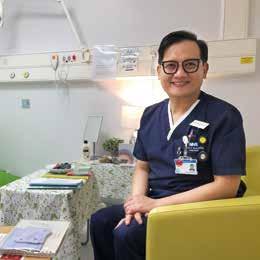

£837 k medical research

£293 k specialist staff training £1.1 million COVID support for staff and patients
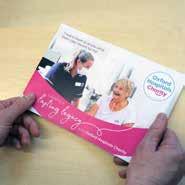

£1.1 million staff support / welfare
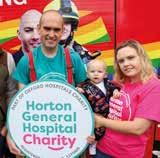

2
million We Spent
£5.5
to your support ... OVER 1
150
pages OVER 8,250 miles ran! OVER 24,000 donations made 67
OVER £1 million gifts in kind for our COVID appeal Kind Donations … from gifts in Wills Community Support At the OX5 RUN
Thanks
,
fundraising
legacies
were
... 3
£1.2 million latest medical equipment and
able to do this!
Funding the very best medical equipment
Over the past two years Oxford Hospitals Charity has funded a huge amount of cutting-edge medical equipment.
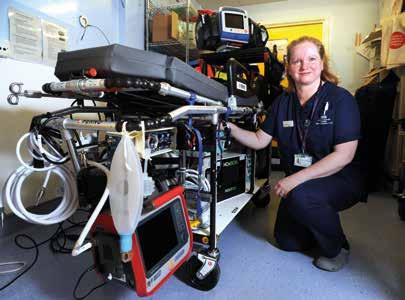
These include major advances, such as an extra CT scanner in the John Radcliffe Emergency Department, which has already been used over 30,000 times, and high-tech neuro-navigation equipment to guide surgeons during delicate brain surgery on children.
Expensive equipment like this – at the forefront of medical technology – is often out of the reach of stretched NHS budgets, and is only provided thanks to the incredible generosity of our charity donors and supporters.
The following examples are just some of the items we have funded, helping equip teams at Oxford University Hospitals with modern medical innovations and bringing better care to our patients – thanks to your very special support.
Helping critically ill children in hospital
Paediatric Critical Care is such an important part of our hospitals; here, the sickest children receive round-the-clock care from a team of experts.
Around 1,000 young patients – from across Oxfordshire, Buckinghamshire, Berkshire, Northamptonshire and, in some cases, the rest of the UK – are cared for every year.
Children and babies recovering from surgery, who’ve been in serious accidents, or have major neurological, cardiac or respiratory conditions, are looked after by a dedicated multidisciplinary team that includes paediatricians, anaesthetists, intensivists and highly trained intensive care nurses, physiotherapists and pharmacists.
If you have spent time in Paediatric Critical Care (PCC), or PICU as it is commonly known, you will know just how high-tech much of the equipment is, and, as a charity, we are always keen to help keep hospital areas like this at the forefront of technology and innovation.
PICTURED: High-tech retrieval trolley, with monitoring equipment
Because in life-or-death situations having the very best kit really does make a difference.
‘ ‘
5 OXFORD HOSPITALS CHARITY IMPACT REPORT 2023
Children in PCC often receive continuous general anaesthetic medications and muscle paralytic drugs, to protect the brain from evolving damage and help their bodies cope with mechanical respiration.
A new EEG machine, costing £55,000, has improved the monitoring and treatment of these young patients – which is particularly important for children with acute neurological and neurosurgical diseases on the unit.
Dr Avishay Sarfatti, Consultant Paediatric Intensivist, told us: ‘Introducing cutting-edge continuous EEG monitoring to Paediatric Critical Care is a huge achievement. It allows us to monitor the function of the brain in a child in an induced coma, alerting clinicians to signs of seizures that could otherwise go undetected.
‘This – and these other important advances – are only made possible through generous donations to our hospital charity and we are so very grateful for this help.’
Another piece of equipment, called a ‘pupilometer ’, is also helping staff obtain more precise information about the children in their care.
Dr Sarfatti explains: ‘The kit digitally measures pupil dilation and responsiveness rather than relying on human assessment – enabling staff to have a non-subjective view on the child’s clinical condition over time, and make better-informed decisions with confidence.’
Oxford Hospitals Charity has also funded three Butterfly Ultrasound Probes. These are all-in-one portable probes that connect to an iPad, so are easy to use and move around. This is particularly useful when a child is being brought to hospital, or when a resuscitation is taking place in another area of the hospital.
This single probe can perform an ultrasound of the entire body, and the advanced software system provides the highest quality visuals – information that can also be quickly shared with other clinical teams.
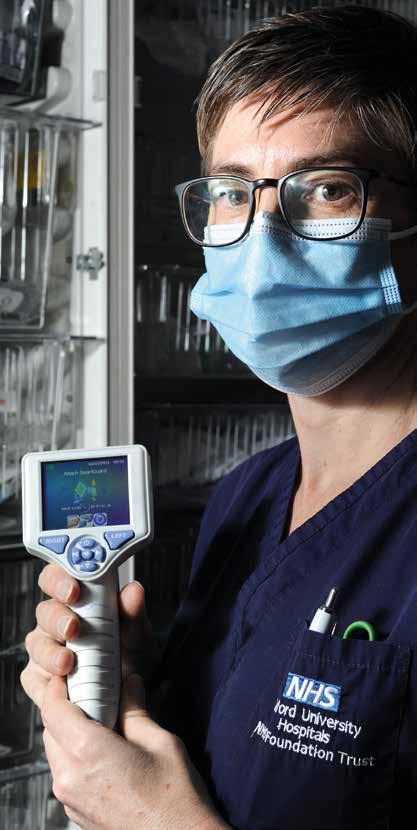
While innovative equipment makes a huge difference, getting a critically ill child to the unit as quickly and safely as possible is also of great importance, and having the right kit to do this can save vital minutes. So, we are pleased to have been able to fund a high-tech retrieval trolley.
This bespoke transportation bed helps to get children to Critical Care via ambulance from surrounding district general hospitals. It is configured to hold an array of medical equipment and monitoring systems, and the team using it can easily see and operate the monitors when in transit.
Over £100,000 of funding
Having this specialist trolley with all the necessary equipment attached saves the team vital time when preparing to leave the unit and reach the poorly child.
In addition to high-tech equipment, we have helped to make the Parents’ Room more comfortable and funded a refurbishment of the Staff Room – because looking after the wellbeing of staff who have to cope with such an intensely emotional job is really important.
In total, the charity has provided over £100,000 of funding to this area in recent months – much of this was donated by some very special families, including the friends and families of Bobby Cox and Amy Evans, who understand very deeply how important PCC is. We share our heartfelt thanks with them.
PICTURED: Another piece of equipment, called a ‘pupilometer’, is also helping staff obtain more precise information about the children in their care
6 Find out more: www.hospital charity.co.uk OXFORD HOSPITALS CHARITY IMPACT REPORT 2023
Pioneering project brings hospital-level care to the home
Oxford University Hospitals is at the forefront of innovations to ease pressures within the NHS – helping patients bypass the Emergency Department and avoid lengthy hospital stays, as well as bringing hospital-level care to patients in their own homes.
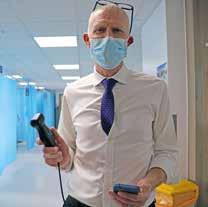
The Ambulatory Assessment Unit (AAU) at the John Radcliffe is one of the nation’s most active ambulatory units, consistently ranked in the UK’s top five.
Here, patients receive medical assessments and tests, treatment and care – all in one day and in one place. This avoids repeated hospital visits and unnecessary overnight stays, with 95% of AAU patients getting home by the end of the day.
Our charity has worked closely with AAU for several years, funding refurbishments to make the ward and waiting areas more comfortable and welcoming for patients and providing wellbeing support for staff through the most testing times of the pandemic.
When the team asked the charity to support their pioneering Acute Hospital at Home programme by funding 11 portable ultrasound machines, we were delighted to help.
Professor Daniel Lasserson, Professor of Acute Ambulatory Care and Clinical Lead for Hospital at Home, explains more:
‘We approached Oxford Hospitals Charity to fund a number of Butterfly iQ devices, portable diagnostic ultrasound systems that allow the speedy diagnosis of serious heart, lung and kidney problems as well as blood clots, outside of the hospital setting.

‘Essentially, they put hospital-level diagnostic systems into the hands of more clinicians and into the homes of our patients.
‘The charity funded £21,000 for this new equipment which the team started to use at the beginning of 2021, when developing the new service.
‘Soon, over 50 scans a month were taking place in people’s homes, with that number more than doubling as the programme grew.
‘ ‘
The support of the charity has been absolutely crucial to the success of the Acute Hospital at Home programme – it helped us to get the whole thing moving and we really are very grateful indeed
Professor Daniel Lasserson
8 OXFORD HOSPITALS CHARITY IMPACT REPORT 2023
PICTURED: handheld ultrasounds can be used in both the hospital and home setting
‘Thanks to this early funding for the equipment, as well as the safe and secure digital system needed for sharing clinical images, the team was able to build the governance infrastructure needed to create this new – and it could be said, revolutionary – way of working in the NHS.
‘This is the first team in the UK to be able to undertake ultrasounds and blood tests, as well as offer a range of intravenous treatments, all in the home.
‘Giving patients the choice to have their acute medical care at home reduces some of the risks associated with hospital admission for our older patients living with frailty. Scans can be instantly shared with other specialists in the hospital through a safe and secure digital system – revolutionising the way we work.
‘And importantly, many patients are much happier to have investigations and treatment in the familiarity of their home setting – as it is convenient, faster and less intimidating.’
The devices have proven so successful that a further 40 units were soon funded through the NHS and the next generation of ‘Hospital at Home’ nurses, physicians, doctors and paramedics are being trained across the John Radcliffe and Horton General –empowering these NHS teams to provide a gold standard service in people’s own homes.
The team’s work was recently featured by BBC One’s Panorama programme ‘The NHS Crisis: Can it Be Fixed?’ – as an example of an innovation to modernise the NHS as it tries to cope with an increasingly ageing population.
The portable ultrasounds took a starring role in the programme, with Professor Lasserson seen using one with a patient in their home to diagnose heart failure.
The work is also being shared with other medical settings across the UK and indeed around the world. Professor Lasserson adds: ‘We are really proud of what we have achieved here, and intend to keep innovating and pushing forward.
‘The support of the charity has been absolutely crucial to the success of the Acute Hospital at Home programme – it helped us to get the whole thing moving and we really are very grateful indeed.’
Donations, fundraising and gifts in Wills to Oxford Hospitals Charity allow us to support innovative work like this. Often our funding of new equipment and tech systems enables exciting new ideas to get off the ground – and in time become part of standard NHS working practice.
Transforming paediatric brain surgery
Thanks to the generosity of our donors, we have been able to fund innovative medical equipment to transform surgery on children with brain tumours.
Almost a decade ago, Oxford Hospitals Charity funded our Trust’s first neuro-navigation image guidance system for the Paediatric Neurosurgery Team, affectionately referred to as a ‘brain satnav’.
At the time, it revolutionised the way brain surgery on children was performed in our hospitals, allowing surgeons to digitally track their route through the brain, determining the safest way through delicate brain tissue to the tumour.
Since it was purchased hundreds of procedures have taken place, helping surgeons save children’s sight, speech, understanding and motor function.
But medical technology moves fast, so recently the Neurosurgery Team successfully applied to the charity to replace and upgrade the equipment, introducing impressive new features.

Whilst Oxford’s paediatric neurosurgeons are exceptionally skilful, the precision required to safely locate, reach and remove a tumour from a child’s brain is extremely intricate.
By using this new improved neuro-navigation system, the team has an even better chance of removing more of the tumour with pinpoint accuracy, causing less damage to the brain and minimising the risk of long-term complications. This gives our young patients the best possible opportunity for a normal adult life.'
Mr Amedeo Calisto, Consultant Paediatric Neurosurgeon and Clinical Lead (pictured left) said:
‘This is marvellous news. We are extremely grateful to Oxford Hospitals Charity and their wonderful donors’ big-hearted benevolence.'
10 11
OXFORD HOSPITALS CHARITY IMPACT REPORT 2023
Mr Calisto continues: ‘Empowering surgeons with this state-of-the-art technology has irreversibly shaped the future of paediatric neurosurgery in the Thames Valley and beyond. This will allow us to push the boundaries of what is currently achievable, and develop further innovative ways to treat rare and deadly brain conditions.
'It is truly the cutting edge of modern surgical technology, fully integrable with other equipment in the operating theatre, including the Brainlab virtual reality headsets, also funded by Oxford Hospitals Charity in 2022.
‘The headsets allow the surgical team, in the planning stage of the operation, to visualise in 3D the target and the neurological structures to protect during the surgery, in the same way an airline pilot would use a flight simulator before taking off with a full 747.
‘This is another huge step forward for our service and presents an incredible opportunity to offer a treatment second to none in the world.’
The funding of £300,000 for the project also purchased a fully integrated ultrasound module. This is used to overlay brain scans acquired before the operation and real-time images taken ‘as you go’, to be confident that every part of the tumour has been successfully removed at the first attempt, while the operation progresses.

Without the ultrasound module, the operation would need to end, and the child would be sent for an MRI. If any part of the tumour was still evident, the child would then need to undergo a second operation adding extra time, anxiety and risk.
Surgeons at Oxford Children’s Hospital started operating with the new equipment in October 2022 and are already delighted with the results.
Tamsin Rawlings, Major Gifts Manager at Oxford Hospitals Charity, commented: ‘We are so grateful to the generous donors who helped fund this project. This latest equipment is considered the gold standard of care for patients and the difference it will make to so many families – at the most difficult time imaginable – is simply immeasurable.’
Empowering surgeons with this state-of-the-art technology has irreversibly shaped the future of paediatric neurosurgery in the Thames Valley and beyond.
PICTURED: Mr Amedeo Calisto, Consultant Paediatric Neurosurgeon and Clinical Lead, with the new neuro-navigation image system
‘ ‘
12 13 OXFORD HOSPITALS CHARITY IMPACT REPORT 2023
Bringing the best CT scanner technology to emergency patients
A major expansion of the John Radcliffe Emergency Department in 2021 created nine extra bays for the care of seriously ill patients. Thanks to a very generous gift left in the Will of a kind-hearted local man, our charity was able to support this important project by funding an extra CT scanner in the resuscitation department, to help speed up diagnosis and treatment for the very sickest of patients.
‘It also allows more dynamic and efficient teamwork to prioritise critically unwell patients and reduce delays in scanning them. The CT scanner is making such a difference.’
Over 30,000 scans
This state-of-the-art equipment, which cost over £820,000, has already been used by over 30,000 patients since it was installed.
CT scanning or Computerised Tomography scanning, to give it its full name, and cross-sectional imaging, are a key part of diagnosing a wide range of emergency conditions, and make a vital difference to the most seriously ill or injured patients coming into the Emergency Department.
Jamie New, CT Superintendent Radiographer, explains: ‘Having this dedicated CT scanner in the resuscitation department means scans can be done more quickly, without having to send patients off to other areas of the hospital.

Douglas Graham, Chief Executive Officer of our charity, said: ‘We are really pleased that the charity was able to help support this crucial development.
It is incredible to see how many people have already benefitted, helping them at their time of greatest need. And this is all thanks to a precious gift included in a Will: it’s so inspiring.’
The charity has also funded comfortable furnishings for the bereavement and relatives’ rooms as well as a series of artworks and light boxes to bring natural light into the Emergency Department alongside bright, friendly artwork and seating for the Children’s Emergency Department.

Gifts in Wills, like the one that funded this equipment, contribute over a third of our charity’s income every year, and help us to fund many of our largest projects. In the current financially stretched times legacies have never been more important to charities like ours.
We are so grateful to those thoughtful and generous individuals who include Oxford Hospitals Charity in their Will, for the benefit of their local community and future generations to come.
If you’d like to find out more about how gifts in Wills help us transform our hospitals, please visit:
hospitalcharity.co.uk/legacy
14 15
OXFORD HOSPITALS CHARITY IMPACT REPORT 2023
Extra CTG monitor for maternity, thanks to nurse’s support
In early 2020, Rob and Rachel Wilcock experienced the joy and heartache of both becoming parents and losing a child. Tragically, baby Zoe died before birth, while her twin sister, Keziah, was born prematurely, needing urgent specialist neonatal care.
Rob Wilcock, who works at the Horton General in Banbury, told us, ‘The empathy, kindness and professionalism we received during such a difficult time was just outstanding. As a nurse, I recognised that this was the kind of care I aim for.’
Happily, baby Keziah has made a full recovery, and the grateful Wilcock family raised an amazing £6,000 for Silver Star Maternity Fund, which is part of Oxford Hospitals Charity.
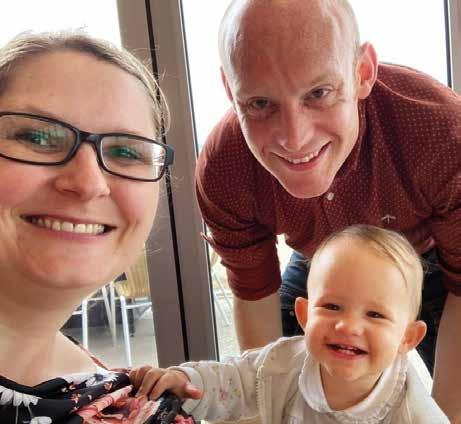
In 2022, this generous donation funded an additional machine to monitor the baby's heartbeat while still in the womb. The Antepartum Foetal Monitor is a computerised monitor that uses cardiotocography (CTG) to monitor, record and analyse the patterns of the heartbeat.
Designed to improve the standard of obstetric care, this equipment is linked to the patients’ records, so the information gathered can be viewed across all areas of the hospital and continuously checked to maintain and improve its diagnostic accuracy.
It is used with women who are over 26 weeks pregnant, providing a clear visual and detailed information about the health of the baby. It can be wheeled to patients’ bedsides for ease of use by the staff, and be adjusted depending on whether the mother is carrying a single baby, twins or triplets.
Midwife Maddie Hall said: ‘This machine is invaluable to the maternity team and used on a daily basis to reassure women with high-risk pregnancies, for example, those with pre-eclampsia, when there is a concern about reduced foetal movements.’
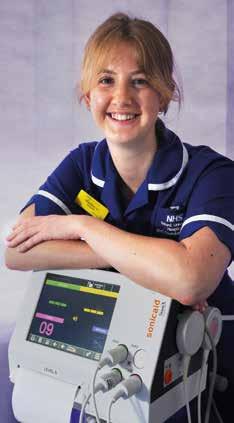
Maggie Findlay from our Silver Star Maternity Fund, which supports maternity services across the John Radcliffe, said:
‘We are so very touched by Rob and Rachel’s kind and generous fundraising, and also their supportive words, which mean so much to the team.’
‘ ‘ 16 17 Find out more: www.hospital charity.co.uk OXFORD HOSPITALS CHARITY IMPACT REPORT 2023
Rapid relief during surgery
The operating theatres at the Churchill Hospital in Oxford are the regional centre for cancer surgery, delivering multiple complex operations to remove cancerous tumours every year.
Funding of £18,000 has been provided for a Rapid Infuser – technology to treat severe blood loss during surgery – which means the team now has the very latest equipment to help when the unexpected happens.
This is the most advanced type of rapid infusion device currently available; it helps combat both hypothermia and blood loss by rapidly delivering life-saving warmed blood and fluids.
Consultant Anaesthetist and Clinical Director Mark Scarfe told us: ‘Though the risk of severe blood loss during operations is low, when it does occur there can be very significant consequences.
'This device improves our capability to deliver blood and blood products to patients who are bleeding, leading to better outcomes for patients. Having the best available equipment helps enable and empower staff to deliver higher quality of care.’
Ella Cooper from the Programme Team at Oxford Hospitals Charity, said: ‘We expect that over 500 patients will be positively affected by the use of this equipment per year, which will have a huge impact across the hospital, so we are absolutely delighted to fund this important equipment.’
£18,000 of funding
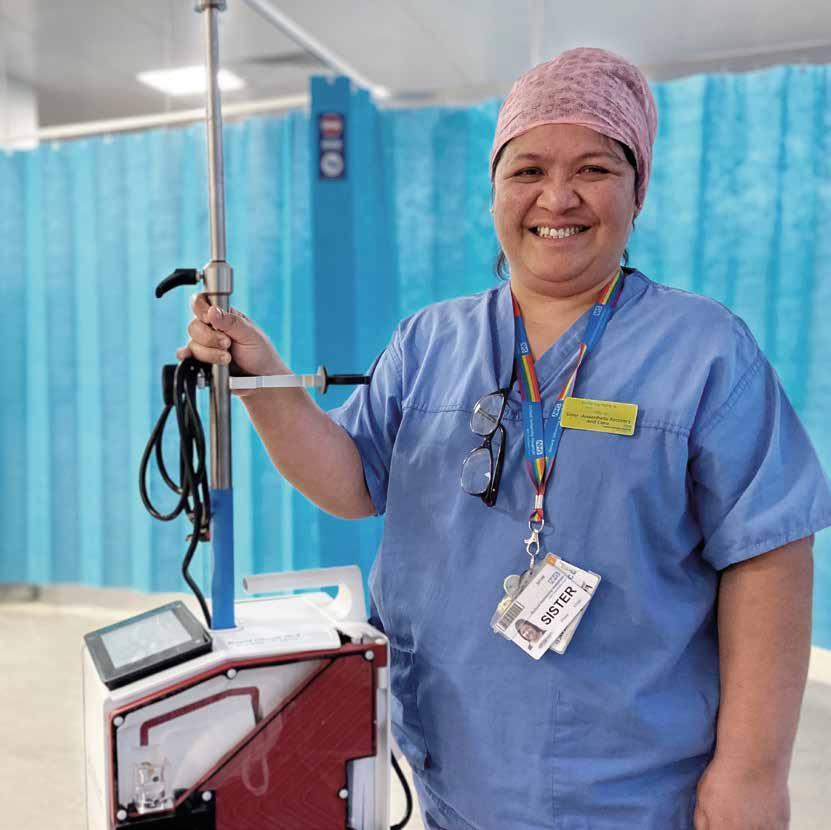
Having the best available equipment will enable and empower staff to deliver an even higher quality of care.
‘ ‘ 18
Mark Scarfe, Consultant Anaesthetist and Clinical Director
OXFORD HOSPITALS CHARITY IMPACT REPORT 2023
PICTURED: Sister Josefina Marticio at the Churchill Hospital, with the new rapid infuser
Little cube with a BIG impact
New equipment for super-accurate genotype testing has been funded, because knowing the right dose of medication to prevent blood clotting is paramount when dealing with patients with complex medical issues.
The Neuro-interventional Radiology Department at the John Radcliffe Hospital is the regional centre covering Oxfordshire, Buckinghamshire, Berkshire, Northamptonshire and Swindon, seeing 280 patients annually.
Oxford Hospitals Charity purchased a Genotype Testing Machine for the department in 2022, called a Smarten Cube. It ensures that patients with aneurysms or recovering from strokes receive the correct anticoagulation medications prior to endovascular treatment.

Many of these patients either don’t respond to standard drug therapies, or over-respond, both of which can increase the risk of complications following hospital procedures.
Rodney Cameron, Interventional Modality Manager at Oxford University Hospitals, explains: ‘The Smarten Cube is a high-accuracy genotype test that uses a cheek swab taken at a patient’s bedside and gives a result in just 60 minutes.
‘The results inform clinicians whether a patient will respond normally to standard medications or not, reducing the chance of strokes or debilitating brain bleeds.
‘For people who over-respond to certain medications, checking their genetics means they will be on the correct dosage, as they might need a lower one than average.
‘After going through a traumatic medical crisis, it gives patients the best chances of recovery, making an enormous difference to their physical and mental health.
‘Patients will have a lower risk of haemorrhaging, as clinicians can safely confirm that they can use less aggressive anticoagulation medicines.
‘This support will make a lasting and positive difference to many people’s lives.’
‘ ‘ 20 21 Find out more: www.hospital charity.co.uk OXFORD HOSPITALS CHARITY IMPACT REPORT 2023
‘Put simply, being on the right medication, at the right dose, is paramount for patients with these complex issues.’
PICTURED: The clinical team celebrating the new genotype testing machine
Bespoke surgical guides bring innovative treatment for sarcoma cancer patients
A pioneering new way of operating on patients with bone cancer is taking place in Oxford, thanks to the surgical and technical teams at the Nuffield Orthopaedic Centre (NOC) and the support of Oxford Hospitals Charity.
The surgical resection of bone sarcomas – where a tumour extends in or through a bone – is a highly complex field. And the Sarcoma Unit at the NOC is one of only five specialist centres in the UK with expertise in this area.
'These predetermine the surgeons’ cuts of the bone, preserving the maximum amount of healthy tissue, while providing a safe margin around the tumour. It allows us to only remove what is absolutely necessary –which makes a huge difference to outcomes.’
Over £60,000 of funding
Surgical cutting guides are emerging as an innovative new tool in this field, and when the NOC team requested funding of £60,000 to introduce this new technology to our hospitals our Trustees were impressed by the possibilities and delighted to approve funding.
The two-year trial, which will include 20 bone cancer operations, is now underway.
Surgeon, Ather Siddiqi, explains: ‘An exact replica of the bone and tumour is created, bespoke to each patient, by merging their CT and MRI scans, then manufacturing it, in-house in a 3D printing facility.
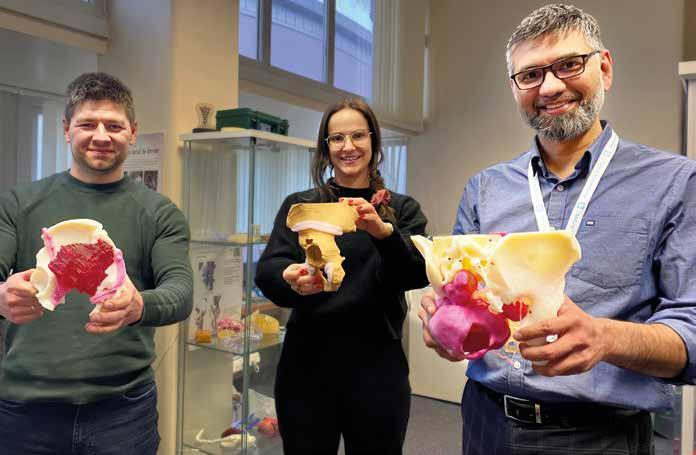
‘This replica helps the surgeon visualise and plan each operation and is also used to create cutting guides that are an exact fit for the individual patient’s anatomy and shape of the tumour.
‘The guides are then also manufactured by 3D printing in sterilisable, bio-compatible materials, before being used for millimetre precision cutting during surgery.
These operations, performed on both children and adults, require a multidisciplinary approach and can be extremely complex – with patients’ lives at stake.
Hazel Murray, Head of Programme at Oxford Hospitals Charity, adds: ‘The team has told us that 16 cases have now successfully taken place, and these guides helped with pre-surgical planning as well as reducing the patients’ loss of blood and time in theatre, and making the recovery time quicker. It’s a real advance.’
The work is also providing important research in the field, with the early results recently presented at the biggest orthopaedic sarcoma conference in Europe, as well as the International Society of Limb Salvage Surgery (ISOLS) in Los Angeles, USA.
With the help of the trial the Oxford Sarcoma Service has pioneered the routine use of this technology in their field and after the very encouraging results from Oxford, other trusts are now employing this technology.
22 23
Find out more: www.hospital charity.co.uk OXFORD HOSPITALS CHARITY IMPACT REPORT 2023
Breakthrough spine surgery at the John Radcliffe Hospital
The John Radcliffe has become one of only a handful of hospitals in the UK able to offer pioneering full endoscopic spine surgery to its patients, thanks to equipment funded by Oxford Hospitals Charity.
Endoscopic surgery is the latest generation of minimally-invasive spine surgery. The entire operation is done through a port (like a tiny puncture) and doesn’t require a large incision in the skin or muscle, reducing muscle damage and decreasing back pain after an operation.
‘It has many benefits, including bloodless operations, less scarring and quicker rehabilitation to normal life. In fact, it allows most patients to be sent home the same day, which is good for all concerned and saves vital NHS funds. The operations are shorter, and the recovery is quicker.
Thanks to the pioneering work of the hospital team and funding of £108,000 from the charity, over 100 patients a year are now able to benefit from this state-of-the-art surgical technique.
Mr Murtuza Sikander (pictured right), Consultant Neurosurgeon and Spine Surgeon at Oxford University Hospitals, said: ‘Endoscopic surgery is well established in brain, abdominal and hip and knee surgeries, but is new to spine surgery.
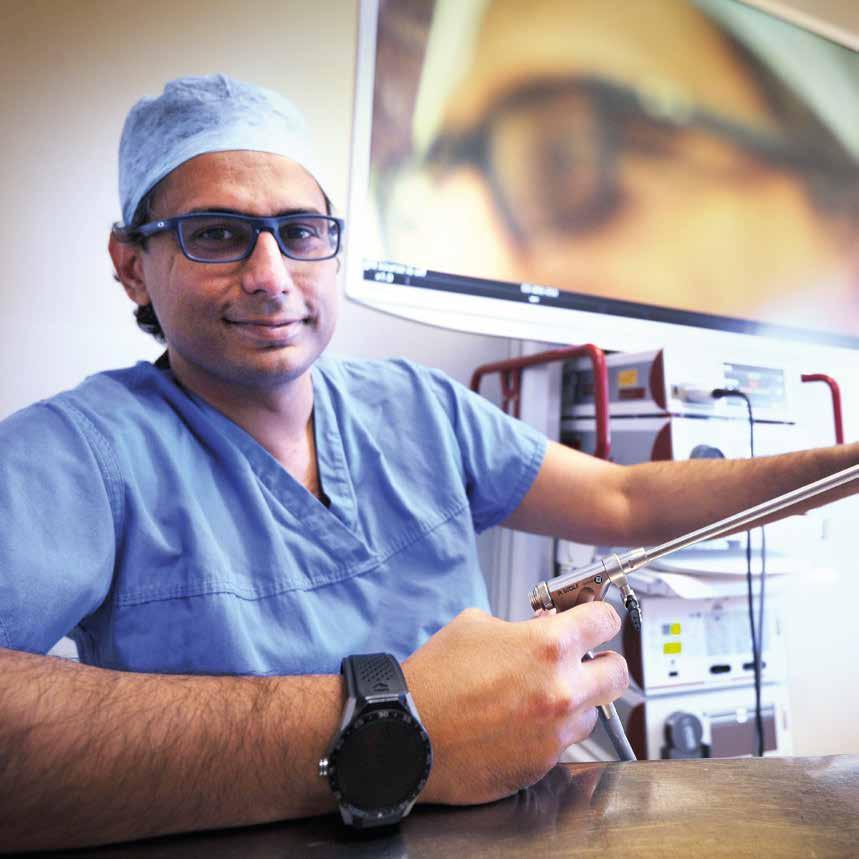
‘So this equipment, alongside previous kit funded by the charity, will extend the range and number of endoscopic spine procedures that can be carried out in the Trust.
‘We are delighted to now be able to offer this gold standard technique and would like to thank Oxford Hospitals Charity and their generous donors who funded this very specialised equipment.’
‘ ‘
In early 2023 the team was recognised as a national and international training centre of excellence in spine surgery, and say this was only possible thanks to this new equipment.
24 OXFORD HOSPITALS CHARITY IMPACT REPORT 2023
Bringing world-class laser surgery to pancreatitis patients
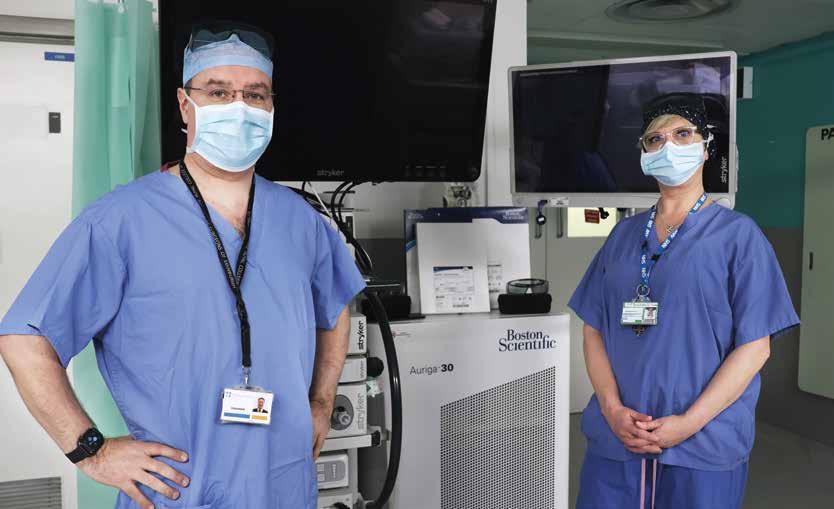
A revolutionary surgical technique to help patients with complex gallstone disease has been introduced with the support of funding from the charity.
Oxford University Hospitals NHS Foundation Trust is only the second NHS Trust in the UK to offer this pioneering procedure, which uses laparoscopic lasers to break up gallstones and remove the gallbladder.
‘Previously patients would first need an endoscopic procedure, and then later the removal of the gallbladder by inserting a tiny video camera and special surgical tools through four small incisions.’
Mr Bond-Smith, a Consultant Surgeon with a specialist interest in emergency biliary surgery, adds: ‘This new procedure has allowed us to reduce the length of hospital stay to just one day – which is much better for the patients, and a significant financial saving to the Trust.
'It will also put the hospital on the map as the only centre in the UK to have this option available in the emergency setting'.
Oxford will also be the only place in the UK to offer the treatment in a real-time emergency setting.
Laura Cuthbertson, Laser Lead Senior Operating Department Practitioner, explains: ‘This is going to make such a difference – with potentially over 700 patients benefitting from this new technique every year.
‘Laser Assisted Bile Duct Exploration utilising Laparoendoscopy, or LABEL procedure as we call it, is keyhole surgery that breaks down the common bile duct (CBD) gallstones into tiny pieces and removes the need for patients to have a second invasive operation.
‘The technique uses laparoscopic lasers to shatter the gallstones which can then be passed naturally in much the same way as kidney stones are routinely dealt with.
An £80,000 gift from a generous charity donor to Oxford Hospitals Charity has funded all the equipment for this innovation – covering the costs of laser glasses, surgical instrument kits, theatre reconfiguration and a significant amount of training to ensure the success of the project.
In December 2022 the team at the John Radcliffe Hospital was able to treat their first patient, with an operation to remove the gallbladder and then remove the complex CBD gallstones, all at one time.
Laura, who works alongside Consultant Surgeon Mr Giles Bond-Smith (both pictured right), said:
‘We are thrilled at how well it has gone. We have set up a world-class laser service.'
'The whole team has worked so hard to make this advance happen.'
26 27 OXFORD HOSPITALS CHARITY IMPACT REPORT 2023
‘None of this would have been possible without the fantastic, and significant, donation by a donor with a specific interest in this area, to whom we are most grateful. ’
Robotic microscope brings surgical advances
Oxford Hospitals Charity provided funding of £262,000 in 2020 for a state-of-the-art robotic digital microscope, helping surgeons at the John Radcliffe Hospital operate on children and adults with brain and spinal conditions.
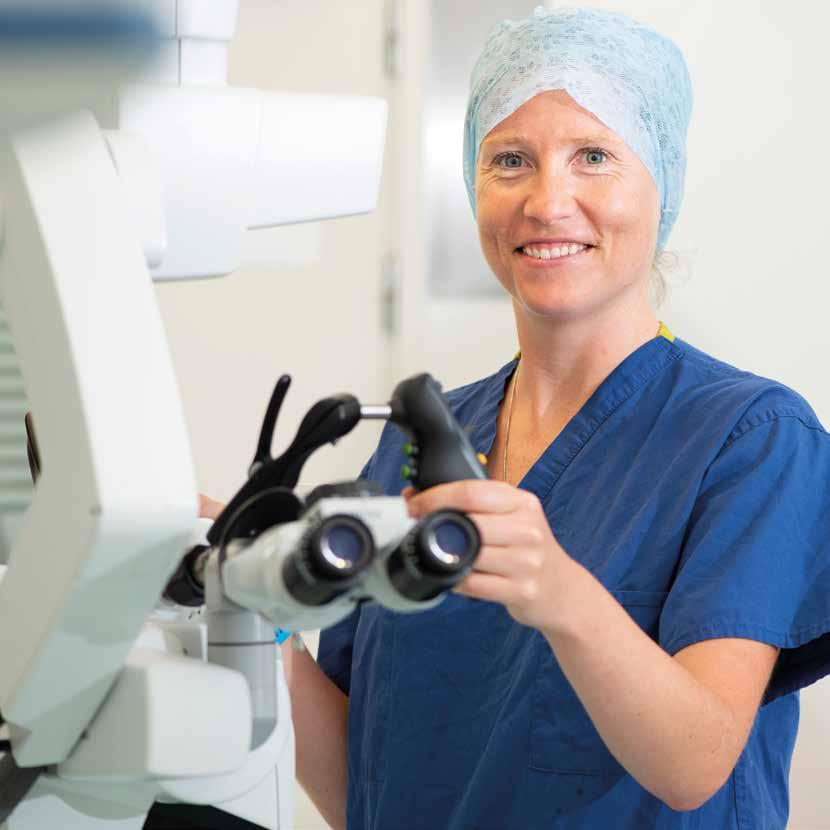
Jash Patel, Consultant Neurosurgeon, explains: ‘This is a really exciting moment for our team. Previous technology improved the magnifying power of microscopes, but the integrative and multipurpose functions of this microscope is a huge step forward.
‘The robotic microscope gives continual pinpoint accuracy for viewing tiny structures of the brain and spine, such as blood vessels and nerves, assisting the accurate and safe removal of tumours and the treatment of life-threatening, painful and disabling neurological conditions.’
The Kinevo 900 micropscope will be used in around 800 operations a year on patients needing delicate surgery to remove brain or spinal tumours, or vascular abnormalities such as aneurysms. Patients of all ages from across Oxfordshire – and the surrounding counties – will benefit from this improved technology which gives surgeons and the theatre team a complete 3D view. And the equipment can work alongside other neurosurgery technology funded by the charity.
this frontier technology.
Consultant Neurosurgeon Ms Jane Halliday (pictured) added: ‘It is a real improvement in the operating theatre, and the teaching opportunities it offers for the team of surgeons, anaesthetists, theatre and scrub staff are fantastic. This transformative equipment is a real boost to our team. Thank you to all those who made this possible.’
In 2023 the charity funded another £96,000 to further upgrade this and one other microscope.
‘
‘
28 OXFORD HOSPITALS CHARITY IMPACT REPORT 2023
The robotic microscope means the next generation of neurosurgeons will benefit from being taught and trained using
High-tech eye testing equipment
Every year around 400 children and adults have unexplained vision loss or other abnormalities detected during routine eye tests, and are sent to attend the Oxford Eye Hospital for further diagnostic examinations.
These abnormalities can be caused by undiagnosed inherited eye disease, eye injury, strokes, or may be the first signs of a previously undetected brain tumour. It can be a very worrying time, particularly for children and parents.
Once referred to the Optometry team at Oxford Eye Hospital, patients need to have a visual field test to assess the extent and sensitivity of their peripheral vision.
The results can help diagnose where in the visual pathway, between the eye and the brain, the abnormalities have occurred. Examples of brain related causes of loss of vision include stroke and tumour of the pituitary gland.
Head of Optometry, Patsy Terry, explains: ‘Though the majority of adults can manage to perform an automated visual field test, some patients, for example those with additional needs or who have had a stroke, as well as younger children, can find it difficult to perform the test reliably.
Customised heart lung bypass machine making a difference
‘With these patients we had to use machinery that had its design set in the sixties, and manually record the results, which was very time consuming.
‘So we applied to Oxford Hospitals Charity for funding of £41,000 for a Digital Kinetic Visual Field Machine, called an Octopus 900. This new equipment has the advanced digital interface for the clinician to control, customise and adapt the test to give the most accurate results.
‘It eliminates lengthy manual hard copy recording processes, speeds up appointments and enables the service to be fully digitised.
‘The test strategy for each patient can also be saved and then compared with subsequent visits to look for changes. This can avoid further MRI scans in the cases where we can prove that field loss is stable.

‘This makes such a difference for the team and crucially for our patients. We are incredibly grateful for this new equipment.’
Heart lung bypass machines are indispensable for cardiothoracic surgery. They do the work of both the lungs and the heart and without them most open heart surgery would not be possible.
Typically around 700 operations take place annually using four heart bypass machines operated by the team; machines that are large, wide and cumbersome, and take up a lot of space in the operating theatres.
The charity provided funding of £35,000 to convert one of the existing machines into a more compact version – making it much easier to move when needed for emergency treatment in other areas of the hospital.
Ian Harvey, Clinical Perfusion Manager, thanked the charity for its support, saying:
‘The modified machine is now the backbone of the service. It is much easier to manoeuvre and takes up less space in the operating theatre. It is particularly useful if we are required to provide emergency support in the cath labs or Cardiac and Thoracic Critical Care.’
The whole team would like to share our thanks to the charity for this important funding.
Ian Harvey, Clinical Perfusion Manager
Over £35,000 of funding
30 31
Find out more: www.hospital charity.co.uk OXFORD HOSPITALS CHARITY IMPACT REPORT 2023
‘ ‘
PICTURED RIGHT: Eye hospital clinicians using the new equipment
COVID-19 RESPONSE
When the Call came, we were there
The pandemic was a period when more was asked of our charity than ever before, and our community showed just how much they cared about their local hospitals.
In March 2020 the Oxford Hospitals Charity team set itself up to perform an emergency support role, adapting like never before to help our Trust in every possible way.
With our fundraising events cancelled, we launched an emergency COVID-19 appeal and rolled up our sleeves …
Streets were quiet, supermarkets empty and vaccines seemed a long way off. It’s easy to forget how frightening the start of the first wave was.
The charity took on the huge task of coordinating the deluge of offers from the public alongside an unprecedented number of requests for help from NHS staff.
Our small team handled hundreds of calls every day – we changed from a primarily grant-giving charity to an emergency response organisation.
Throughout this intense period of the pandemic, we did everything possible to support the needs of patients and staff in our hospitals.
The charity joined daily NHS emergency planning and communications briefings and reached out to frontline staff to understand and map the needs across our four hospitals.
Working closely with the Trust’s Voluntary Services, we organised logistics, funding and ordering, while volunteers took delivery and distributed supplies across the hospitals – supporting our staff and patients throughout the most complex time in our hospitals’ history.

…
33
PICTURED ABOVE: Throughout the pandemic the charity team worked closely with volunteers to support staff and patients across all our hospitals.
Our focus was to provide practical support and solve problems – fast – allowing stretched NHS staff to get on with the job in hand. This approach continued throughout the pandemic with daily conversations: ‘What do you need? How can we help?’
We provided the support you will have read about many times: drinks, lip balms and face creams for staff spending hours in full PPE. But we went further:

Home monitoring equipment for young cystic fibrosis and heart patients; iPads and chargers for isolated patients; toys for children in hospital as communal ward play spaces closed; meals for parents unable to leave the Children’s Hospital; support for staff in temporary accommodation, nappies for new mums leaving hospital (when shelves were bare) – whatever problems were thrown at us, we went out of our way to solve them.
Our charity was the first to work with the newly created Salute the NHS organisation, quickly getting 700 meals out a day, seven days a week. Our template for making this work was replicated in hospitals across the UK.
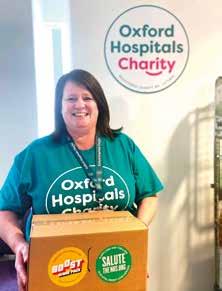
We worked with a printer to fund 2,000 childfriendly books that explained the virus, to reassure young patients and the children of hospital staff, and brought in innovative ways to help patients isolated
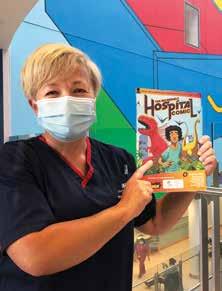
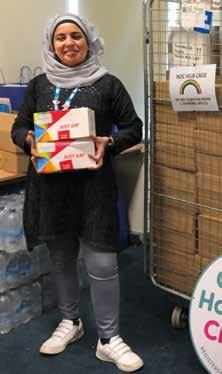
by visiting restrictions – such as virtual music concerts performed live through iPads – and created thousands of patient activity packs with bespoke quizzes and activities for adults in hospital.
The charity also created 20 respite spaces for staff to take a moment to breathe, and within hours of hearing that a much-loved nurse had died, set up a beautiful space for her colleagues to grieve. We also quietly offered practical support to all the families of staff who lost their lives during this time.
During the second major wave, we used all our learnings to create a more structured and less reactive model of support, using funding from the original COVID appeal to make sure we could still help the hospitals through this complex time.
Supporting staff wellbeing and mental health became increasingly important, as the toll of burnout and stress began to show. So, we worked with specialist suppliers to create bespoke ‘boost boxes’ for staff rooms in areas that we knew were most under pressure.
In addition, the role of the arts to release tension and share the complex emotions of the time became clear. Specialist sessions were set up by the charity, including virtual poetry, music and arts workshops –support so successful that much of it has continued long-term through our Artlink Programme.

34 35 Find out more: www.hospital charity.co.uk OXFORD HOSPITALS CHARITY IMPACT REPORT 2023
There was even a virtual Christmas concert, with special guests including Stephen Fry and Clare Balding, created by the charity to thank staff for all their efforts.
Understanding that at some point traumatised staff would be looking for ways to make sense of the pandemic, the charity and Trust worked together to create a book that collected images and stories from staff throughout the pandemic.
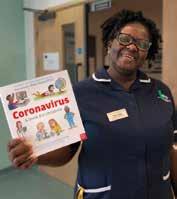

Beyond Words. Images from the COVID-19 Pandemic went on to win a number of prestigious awards in 2022.
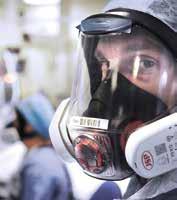

Staff feedback came in waves, with this lovely comment summarising it best: ‘I just want to thank you and all of your team for the wonderful, kind, thoughtful, organised response and the amount of work that is going on behind the scenes to respond at this extraordinary time. How lucky we are to have such a professional, dedicated and enthusiastic team of people driving and galvanising support for all our staff and patients.’
And Sam Foster, Chief Nursing Officer at the Trust, said. ‘The charity has wrapped its arms around our teams since the pandemic began. Thank you Oxford Hospitals Charity for your genuine care for us.'

We cannot thank the local community enough for all their support during this time.
Sam Foster, Chief Nursing Officer
37
‘ ‘
OXFORD HOSPITALS CHARITY IMPACT REPORT 2023
PICTURED LEFT: Horton General Critical Care team during the pandemic
Transforming the hospital experience for patients
Making our hospitals more welcoming and comfortable for patients continues to be a hugely important part of our work.
From creating dementia-friendly spaces and transforming emergency areas to funding music on the wards and physiotherapy kit for rehabilitation – we hope you will agree that the following examples show how the support of the charity is transforming the hospital experience.
The following are just a few examples of the innovations and improvements we have been able to introduce, making a difference to thousands of patients and their families, day in, day out.
Bringing wedding celebrations to our wards
Even during the saddest of times, there are special celebrations taking place in our hospitals.
The Chaplaincy team at the Churchill Hospital’s Oxford Cancer and Haematology Centre asked the charity to help them create 12 beautiful wedding boxes.
This means that when a patient receiving care wants to get married in hospital and time is of the essence, a ceremony can quickly be organised helping to make a special event for the couple.
The wedding boxes – each containing a ring cushion, champagne flutes, confetti, a beautiful card, garlands, balloons and bunting to decorate the bedside, as well as a keepsake box, have now been created.
Reverend Cara Heafey, Chaplain at the Churchill Hospital, said: ‘The boxes were inspired by a ward that went above and beyond at very short notice, to help make a couple’s wedding in hospital a very special occasion.

‘Weddings in hospital happen more than you would imagine, and are often organised with very little time. It is wonderful to now have everything we need on hand to make these occasions as special as possible for the couples.’
Do watch a short video about this support at www.hospitalcharity.co.uk/weddingboxes
39
Introducing child-friendly emergency care to the Horton General
The Horton General Hospital has a new space to look after children needing emergency care.
The Horton Children’s Emergency Unit was created in 2021, with four cubicle spaces, alongside a dedicated waiting room, all designed specifically around the needs of younger patients.
The new space means that children and their families can now wait, and be assessed and treated, away from the main adult areas, which can often be a confusing and distressing place for younger patients.
Horton General Hospital Charity, which is part of Oxford Hospitals Charity, provided £50,000 to make this happen.

National funding was invested for major improvements across the whole of the Horton Emergency Department – but there was a need for extra support to complete a truly child-friendly emergency space.
Emergency Consultant Phil Hormbrey, who worked at the Horton General for over 20 years, said: ‘This dedicated space ensures children are cared for in a secure and calm area, which is exactly what they need.
‘We are absolutely thrilled to be able to offer this to our local community and are delighted, together with the other Emergency Department improvements, to have created a unit that is perfectly designed for the needs of Banbury and the surrounding areas.’
Debbie Kirby, Senior Sister at the Horton Emergency Department, added: ‘Having an area for children makes such a difference to our ability to support the immediate emergency care needs of local young patients. It’s also a tremendous boost for the team here and is something we are all so pleased with.’
Around 11,000 children a year attend the main Emergency Department at the Horton, and with parents and siblings included it is estimated the space will be used by over 37,000 people every year.
Children’s Matron at the Horton, Pippa Parnell, added: ‘The new environment is bright and friendly, and our specialist staff are able to use distraction therapies and techniques to support young patients, away from the adult noise and distress.’
The charity has funded new wall-mounted workstations and computers – giving more space and keeping equipment safely away from little fingers – high-tech observation monitors and childfriendly seating. Wall art has also been created along with new toys and activities to keep children engaged and feeling safe.
Having an area for children makes such a difference to our ability to support the immediate emergency care needs of local young patients.
‘ ‘
Debbie Kirby, Senior Sister
40 41
Find out more: www.hospital charity.co.uk OXFORD HOSPITALS CHARITY IMPACT REPORT 2023
PICTURED: Charity team and Trustees visit the Horton team’s new facilities
Transforming our hospitals through music and art
The arts are proven to have a calming effect in hospitals, reducing stress and anxiety for patients as well as creating more positive working environments for staff.
Oxford Hospitals Charity has a dedicated arts programme called Artlink, that uses visual arts, performance, music and poetry to make our hospitals more welcoming and develops art projects for wards and departments as well as for new buildings.
In the new Critical Care building and Emergency Department extension, artists have advised on colour and furniture as well as creating integrated artwork, using muted tones and nature-themed art to create calm spaces in busy departments.
Working closely with staff, artists addressed the specific needs of patients – from ceiling light boxes filled with images of birds and animals to distract anxious patients having a CT scan, to bespoke ‘window landscapes’ that offer a tranquil view for end of life patients.
In the Horton’s Paediatric Emergency Department, artist Holly Swain’s ceiling tiles of smiling faces and window artwork full of detail are further supported by an activity leaflet to distract and engage young patients while they wait.

In Robin’s Ward, Stephen Smith’s designs include new bed numbers, each with an animal or bird which the child can then go and find in a huge wall artwork and on ceiling tiles in the treatment room.
We also support young patients through our print projects such as The Incredible Hospital Comic, created with The Phoenix comic, which is packed with fun stories and puzzles, and includes a specially commissioned story showing children what to expect when they come in for surgery.
Adult patients can also suffer from boredom, and we provide a range of creative bedside activities funded by the charity – from mindful origami sessions and Harry’s Audio Library, providing audio equipment and reading materials, to our popular colouring and puzzle books.
Hospitals can be particularly confusing and disorientating places for older patients and artwork can help make wards feel more homely and familiar.
PICTURED: Staff and patients enjoy the new Day Care Ward artwork in the Children’s Hospital
Projects for younger patients transform clinical spaces into welcoming places, filled with fun and play.
42 43 OXFORD HOSPITALS CHARITY IMPACT REPORT 2023
A large wall artwork in the Horton’s Trauma Ward by Tom Cross contains ‘favourite things’ gathered from patients and staff. From a beach scene to a circus, digging the allotment to cycling, it provides a wealth of conversation starters for staff to engage older patients and is a useful tool for Occupational Therapists to encourage mobility.
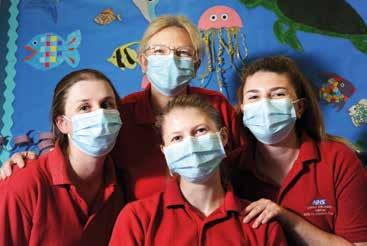

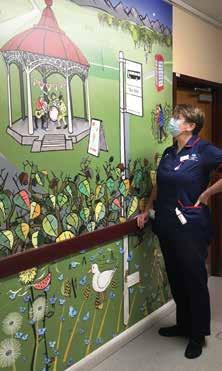
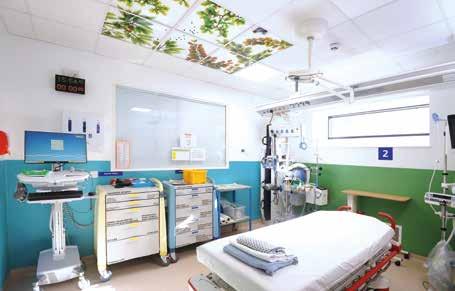
Our Music on Wards programme is a particular highlight. Aimed largely at older patients, it reduces anxiety, lifts mood and helps staff connect with the individual behind the illness.
‘During the long-term restrictions of the pandemic we had to find a new way of delivering our concerts’ Ruth Charity, Arts Coordinator, explains.
‘We created a virtual version of the programme, delivering personalised live concerts and a chat to older patients, all done using the power of Zoom and iPads funded by the charity. Hearing familiar tunes can prompt patients to reminisce, and help make the hospital environment more friendly and welcoming.
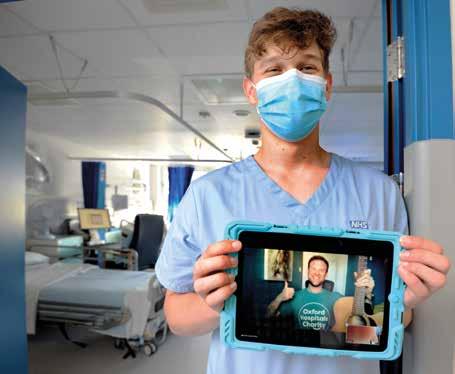
'There is a wealth of research to show how music can engage and stimulate people, particularly those with dementia, so it was really important to keep these concerts going.’
Sarah Saunders, Memory Nurse Specialist, added: ‘The virtual concerts and those done in person really make a difference, and some of the responses to the music are quite extraordinary.
‘It is very special indeed to watch as the music lifts the spirits of our patients, some of whom have been really very low and lonely. It means so much to the whole team to see our patients smiling and laughing and is especially powerful when this involves patients who we normally have challenges communicating with.’
We continue to be very grateful to the charity for this very special programme of work.
Sarah Saunders, Memory Nurse Specialist
13 44 45
‘ ‘ Find out more: www.hospital charity.co.uk OXFORD HOSPITALS CHARITY IMPACT REPORT 2023
Critical Care kit helps patients on their road to recovery

In 2022 the brand-new Oxford Critical Care building opened on the John Radcliffe Hospital site in Oxford.
Caring for around 900 critically ill patients a year, the 48-bed building is a huge advance for patients in need of the most intensive levels of medical support. 45% of patients will spend three days or more in critical care, with most needing significant rehabilitation.
Funding of £25,000 from Oxford Hospitals
Charity for new rehabilitation equipment is helping the Physiotherapy Team to provide first-class care for these patients.
This included a new electronic tilt table. Physiotherapy Assistant, Leanne Fives-Moriarty, told us: ‘We’ve never had a piece of equipment like this, it’s made such a difference.
‘We can slide the patients from their bed to the table, where they are strapped in and gradually raised to a standing position to do their physiotherapy exercises. Being able to see your limbs helps to get the signals from the brain to the body when we are asking the patient to make movements to build strength.
‘It does them the world of good, giving them a sense of normality and helping them get back to the idea of being able to stand.
‘I truly am grateful to the charity and its supporters. It sounds corny, but it means everything to us to be able to look after our patients in this way.’
The charity also purchased a specialist exercise machine which is adapted so that most ICU patients can use it while still in bed, including those who have suffered major trauma or spinal cord injuries or very serious diseases.
It provides inspirational videos and collects data to show the progress the patient is making.
Team Lead Physiotherapist in Oxford Critical Care Rebekah Haylett told us: ‘It’s really good for strengthening arms and legs as well as cardiovascular strength and means we can offer more bespoke and motivating support to help patients reach their goals.
Rebekah Haylett, Lead Physiotherapist
In addition to this equipment, comfortable waiting areas were created for the new building, with specially commissioned landscaped themed artwork for waiting areas, on ceiling tiles and in end of life rooms as well sky-themed light boxes in isolation rooms. These improvements, funded by the charity, help make the unit more comfortable for patients and their families.
46 47
We are really grateful; we have been keen for equipment like this for many years, so it’s made such a difference and has really motivated the team.
‘ ‘ Find out more: www.hospital charity.co.uk OXFORD HOSPITALS CHARITY IMPACT REPORT 2023
A space to say goodbye
Paul Masters and his wife Siobhan, from Chinnor in Oxfordshire, experienced unbelievable heartbreak in August 2020 when they lost their twin baby boys, James and Ryan.

The family had spent precious time in the Ashfield Suite at the John Radcliffe Hospital. This provided a quiet space equipped with cooling cots, meaning they could take their time saying goodbye to James, while Ryan was kept close by in Newborn Intensive Care, before being moved to Helen & Douglas House, where he sadly also passed away.
The family was determined that something positive would come from their loss, so Paul decided to run 365 miles over 365 days, in memory of his boys, raising funds for three charities that cared for his family in their darkest hours, to help other local families faced with similar heartbreak.
Paul explains: ‘Without the support of these charities I honestly don’t know how we would’ve got through what I can only describe as the most awful and challenging time. This is my way of saying thank you to them for letting us have that extra time with our boys which will always be treasured.’
Paul completed his challenge in November 2021, with money from his fundraising for Oxford Hospitals
Charity used to refurbish one of the bereavement suites to help other families.
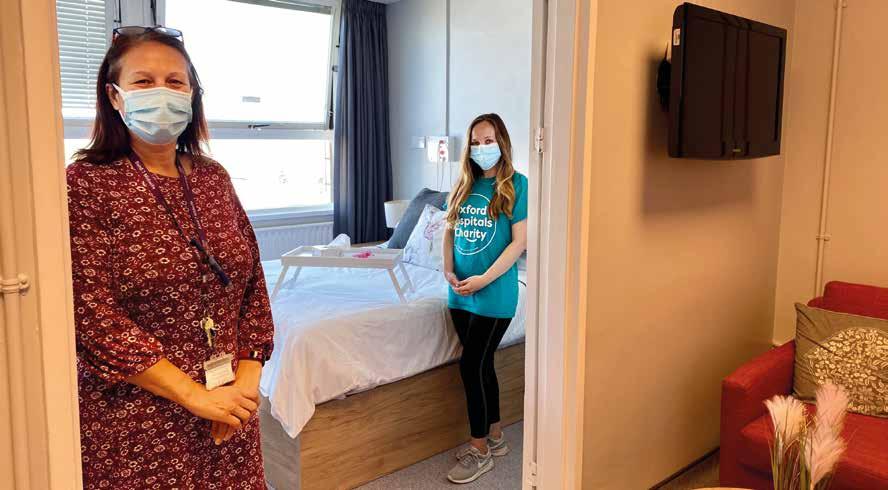
Both the bedroom and bathroom areas of the suite were fully refurbished with new flooring, painting, furniture, bedding, bathroom facilities and artwork as well as soundproofing, to ensure families aren’t disturbed by sounds on the maternity wards.
Paula Gallacher, Bereavement Specialist Midwife at the time, said: ‘The room is now a sanctuary for bereaved parents, when they need it most – peaceful, calm and homely. It is so important to be able to provide a space like this to help give families the time and privacy to say goodbye.’
We are also grateful to the families of Jacob James Murphy and Eva Johnson who have also shown huge courage and compassion following their own baby loss.
New work, funded thanks to these families, is taking place in 2023 to bring further improvements to the unit and create a butterfly memorial garden.
48 49 OXFORD HOSPITALS CHARITY IMPACT REPORT 2023
PICTURED RIGHT: Paul and Siobhan Masters at the BBC Make a Difference Awards
PICTURED RIGHT: One of the newly refurbished bereavement suites
Supporting hospital patients living with dementia
Caring for older patients and those living with dementia within a hospital environment can very be challenging. The unfamiliar surroundings, change of routine, noise and pain can cause confusion and anxiety, and in turn increase the risk of further injury.
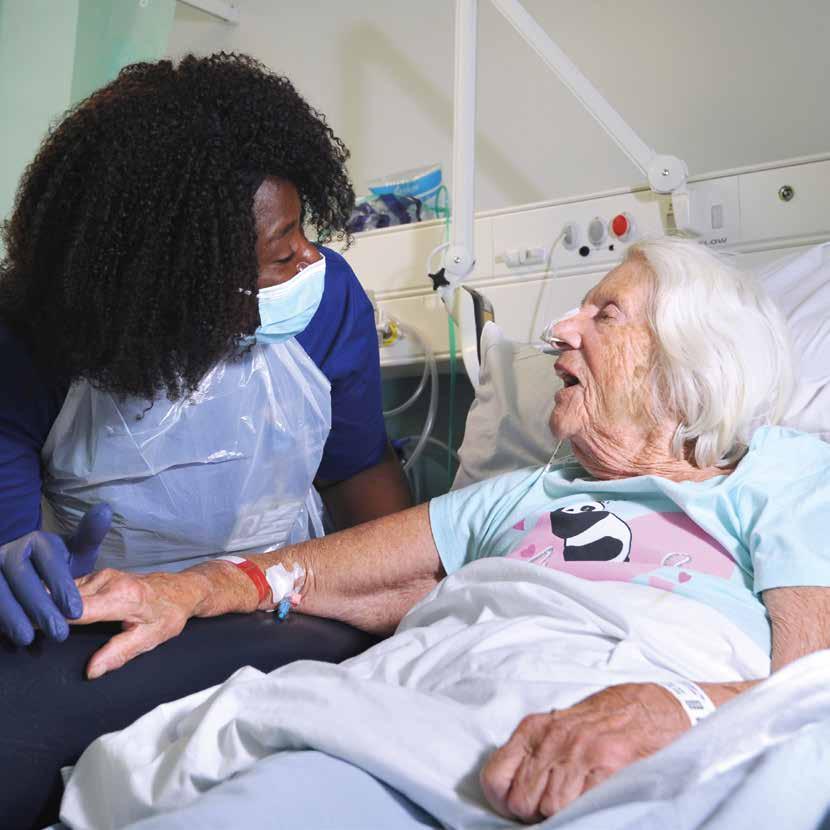
So we were delighted to support the Horton General by creating a dedicated Reminiscence Room, offering patients with dementia a welcoming social space – somewhere they can find comfort and nostalgia.
The new room has been created within the Emergency Assessment Unit at the Horton, where around one third of patients admitted have dementia.
It includes clever touches, such as a Horton Hospital bus stop sign, courtesy of Stagecoach, that can be seen from the corridor to encourage patients who may be wandering to stop in a ‘familiar place’.
Adam Newberry, from the Occupational Therapy team, told us: ‘Patients can become agitated but by including things like the bus stop sign and local images, they are more likely to sit down and relax.’
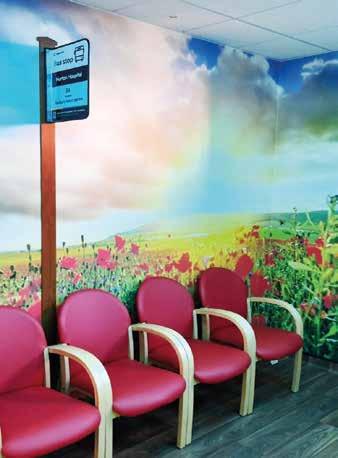
50 OXFORD HOSPITALS CHARITY IMPACT REPORT 2023
The room has a mural and photography of Banbury in older times, as well as therapy dolls and toy animals, designed for people with cognitive loss, a music system, so patients can sing along to their favourite tunes and a large mobile interactive screen on wheels that allows patients of all abilities to take part in games and activities.
Julie Upward, Occupational Therapy Team Leader, added: ‘These are all such great resources to benefit our patients and also help our hospital staff with the therapeutic care.’
Mobile activity trolleys to help those in the Trauma Wards

Staff working in Trauma at the John Radcliffe Hospital also asked the charity to help them occupy anxious and older patients in their care.
This resulted in three ‘distraction trolleys’, loaded up with a variety of resources for patients who may be anxious, upset or disengaged – providing mobile and easy-to-access positive distractions and activities.
Jilly Heath, Dementia and Education Lead, explains:
‘The trolleys are a great way to distract and calm patients. They have a variety of items including drawing and colouring equipment, games, books, squeeze balls, maze boards, dementia radios and ‘twiddle items’, which are small but effective in helping to calm patients, particularly those with dementia.
‘We have also been able to make reminiscence books, which include historical images to help to stimulate the patients’ memories and encourage communication, and ‘Knowing Me Passports’ which can be filled in by family, friends and staff and help us to really understand the individual and their needs.’
Hazel Murray, Head of the charity’s Programme Team, said: ‘We love it when hospital staff come to us with clever ideas like these. The feedback from staff, patients and their families has been great – so we look forward to creating more support of this kind.’
Supporting the new Haemophilia and Thrombosis Centre
The new Oxford Haemophilia and Thrombosis Centre opened in 2022. It is one of the largest comprehensive haemophilia and thrombosis centres in the UK, responsible for the care of 8,000 patients with bleeding and clotting disorders.
The centre was previously located at the Churchill Hospital and moved into a former ward at the Nuffield Orthopaedic Centre which was re-designed and completely refurbished by our NHS Trust.
Funding of £25,000 was also provided by Oxford Hospitals Charity to purchase rehabilitation gym equipment and to make the outdoor space more welcoming and attractive for patients and staff.
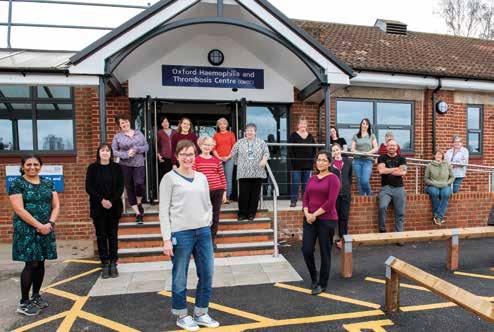
The centre is dedicated to providing specialist care to patients locally, regionally and nationally, including adults and children diagnosed with Haemophilia A, Haemophilia B, acquired haemophilia and other rare forms of inherited clotting disorders.
8,000 patients a year
52 53 OXFORD HOSPITALS CHARITY IMPACT REPORT 2023
Karate classes helping children with chronic pain conditions
Children and young people who suffer from chronic pain can access a very special type of rehabilitation, thanks to the support of Oxford Hospitals Charity and the vision of the Chronic Pain Team.
For several years our charity has funded weekly karate sessions for the rehabilitation programme at the Oxford Centre for Children and Young People in Pain (OXCYPP).
The classes are run by martial arts instructor, Sensei Phil Patrick, who delivers 60-minute karate and selfdefence lessons, designed to help young patients build confidence and engage in activity – improving physical and mental health.
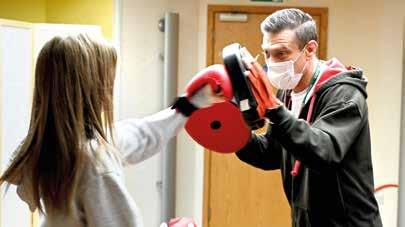

Lisa Fox, Chronic Pain Therapy Assistant, said: ‘We are delighted to offer this wonderful activity to our patients and are really grateful for the charity’s ongoing support.
‘The classes are tailored to the children’s differing abilities and conditions. We’ve had children who use wheelchairs and those who struggle to use their limbs able to take part.
‘And the children absolutely love their sessions with Sensei Phil. They are often surprised by how much they are able to do and many go on to continue taking lessons at home.
‘The feedback from our families always shows this as a real highlight of the week – the sessions are fun and empowering, and it’s great to see children who often find exercise really difficult, up and moving for a whole hour. It’s brilliant.'
Donna, mum to 16-year-old Samuel, who suffers with long-term chronic pain, said she found watching her son take part quite emotional: ‘The way this team supports our children, and in fact us as parents too, is just brilliant. To watch my son doing this karate lesson and see him smiling and having fun is just lovely.’
Karen, mum to 13-year-old Charlotte, who has a condition called Ehlers-Danlos Syndrome, added: ‘It’s great when you have a child who experiences longterm pain to see them enjoying new things and able to increase their activity.
‘There is a protective bubble around you when your child is on the intensive rehabilitation programme, and activities like this karate session help build confidence; your child sees they can do something new.’
Martial arts instructor, Sensei Phil, said: ‘I absolutely love seeing how the kids’ confidence grows during the hour sessions. Many feel quite nervous when they start, but by the end they are really going for it, with big smiles on their faces.’
54 55 Find out more: www.hospital charity.co.uk OXFORD HOSPITALS CHARITY IMPACT REPORT 2023
Groundbreaking Radiology Play Specialist role
In late 2021 Oxford Hospitals Charity funded a brand-new Play Specialist role for Radiology at the Oxford Children’s Hospital to support more young patients having important scans, like MRIs, while still awake.
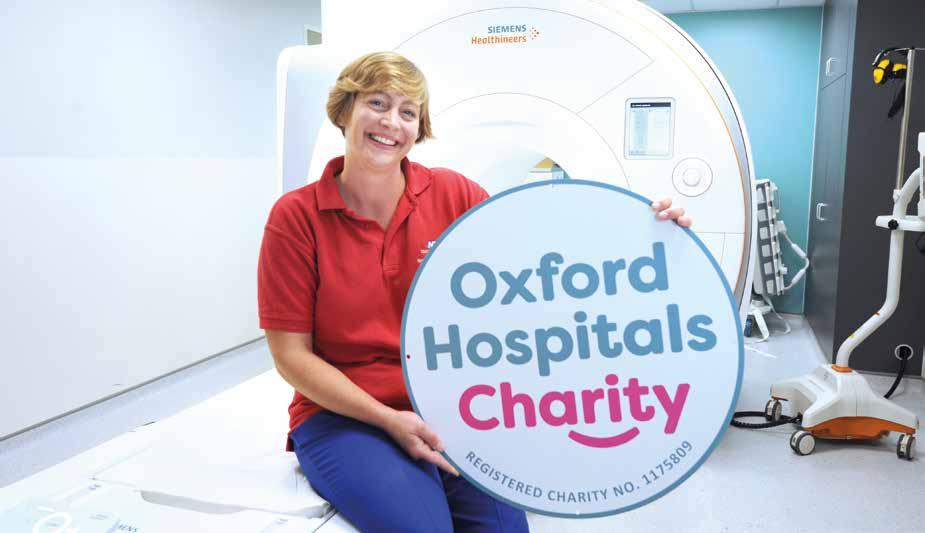
Sonia Dugmore, a Senior Play Specialist, was appointed to use her skills to help hundreds of children avoid the need for general anaesthetic when having scans, allowing them to get home much more quickly.
Some young patients – like those with spinal and brain injuries and certain cancers – have a lot of MRIs, so avoiding the need for a general anaesthetic each time makes a huge difference. Sonia is also helping young patients having Urodynamics, Fluoroscopy and Renal scans.
Sonia Dugmore told us: ‘This post was developed during the pandemic, when our capacity for anaesthetics was significantly reduced.
‘We set up a programme using the skills of a play specialist to try to increase the number of young patients having an MRI while still awake.
‘It was such a success that we wanted to continue this work, and applied to the charity for funding to help.
‘Now many young patients undergoing MRIs, and other important diagnostic scans, have specialist support during their procedures.
324 young patients were referred to the service in the first year of the project.
Of these, over half were assessed as children who would have needed a general anaesthetic without the programme’s support and a quarter were children with additional needs, such as autism, developmental delay or sensory issues.
The youngest child was only three years old, with the majority of patients in the seven to nine years age bracket, having long/complex scans. There are huge benefits to the children and large cost savings for the NHS.
It is estimated that this programme saved the NHS Trust over £250,000 in this one year alone
Funding for this new role has all come from Oxford Hospitals Charity, much of it from the annual OX5 RUN event, which takes place every Spring at Blenheim Palace (see www.hospitalcharity.co.uk/ox5run).
‘I am so excited about the difference this is making for these youngsters across the Radiology departments at the Children’s Hospital, and would like to thank all the charity supporters who helped make this happen.’
56 57
OXFORD HOSPITALS CHARITY IMPACT REPORT 2023
Building hope through art and craft

Oxford Centre for Enablement (OCE), based at the Nuffield Orthopaedic Centre, houses an 18-bed inpatient facility as well as a comprehensive programme for outpatients – providing neurological rehabilitation for patients with brain injuries and those with long-term conditions.
Walking through its doors takes you into a hidden gem within our NHS Trust. With its bright murals, and even sunnier staff, you instantly know you are in a very special place.
Here, advanced therapies are used to provide specialist neurological rehabilitation for patients recovering from, and living with, long-term disabling conditions. The dedicated team help patients improve their physical skills and coordination, using a mixture of traditional and innovative therapies.
Alongside the inpatient wards and physiotherapy equipment, it is a wonderful surprise to see a fully functioning workshop, with occupational therapist technical instructors, John Mercer and Hattie Speed – who are also trained furniture makers – teaching woodwork skills to patients.

58
PICTURED: Therapist Jo Brown in the art room at the Oxford Centre for Enablement
Spend any time with them and their passion shines through – it quickly becomes clear that giving patients the skills to create something – maybe a bird house or jewellery box – can have an amazing effect on recovery.
John Mercer (pictured above right) explains: ‘We have patients who have had strokes or serious accidents and feel they have lost everything. They can be very depressed and really don’t think they could possibly manage to use tools to actually make something.
‘But it doesn’t take long for them to become fully immersed in the work and you see their physical skills and confidence grow.’
Funding for woodworking tools and equipment helps the sessions reach many patients – even those working remotely at home.
Entering the art room next door, you can’t fail to notice the hundreds of creations covering every surface, but it is Jo Brown’s big smile and effervescent personality that stand out most.
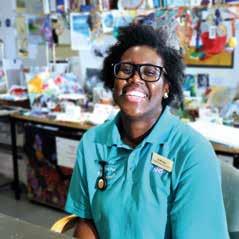
To say Jo is passionate about her work is an understatement. She talks excitedly about how art and craft not only help hand-to-eye coordination but can also help to bring back her patients’ sense of self and hope for the future.
‘To see the effect on someone who has very limited mobility as they find the skills to create something beautiful is just amazing,’ Jo tells us.
‘The work helps our patients with their physical rehabilitation, and simultaneously their mental health improves. They really look forward to these sessions –it is a wonderful thing.’
Thanks to your donations, Oxford Hospitals Charity is able to support this innovative work by funding materials and specially adapted equipment for the workshops

Jo proudly demonstrated the art table that rises and tilts to match the exact needs of the patient she is working with, meaning those with even the most severe disabilities can take part. The table was funded by donations from the Greenaway family after their teenage son, Harvey, received support following a serious car accident.
Our charity has also funded interactive screens that allow other one-to-one sessions, including music therapy and even photography, to take place remotely – bringing creative and rewarding therapies to a wider group.
The centre even includes a little garden, where a new shed and gardening equipment has been warmly welcomed by the team.
The Physiotherapy Team has also benefitted, with funding for enhanced walking rehabilitation equipment, to help patients with brain injuries on the journey from wheelchair to walking again.
On the clinical side, the charity has funded a second portable ultrasound system for OCE, to help patients with central nervous system damage who need very large injections into their muscles to help calm tremors. The ultrasound increases the accuracy of the injections, making the process less painful and more effective.
The staff we have met across the centre exude energy and enthusiasm, and were unanimous in thanks for the charitable support of their very special work. See Jo explain more about how art is transformative in hospital at:
www.hospitalcharity.co.uk/ocevideo
60 61 Find out more: www.hospital charity.co.uk OXFORD HOSPITALS CHARITY IMPACT REPORT 2023
Using virtual reality to distract and calm younger patients
Young patients at the Horton General and Oxford Children's Hospital can now be distracted and entertained thanks to high-tech virtual reality (VR) headsets used during difficult or complex procedures.
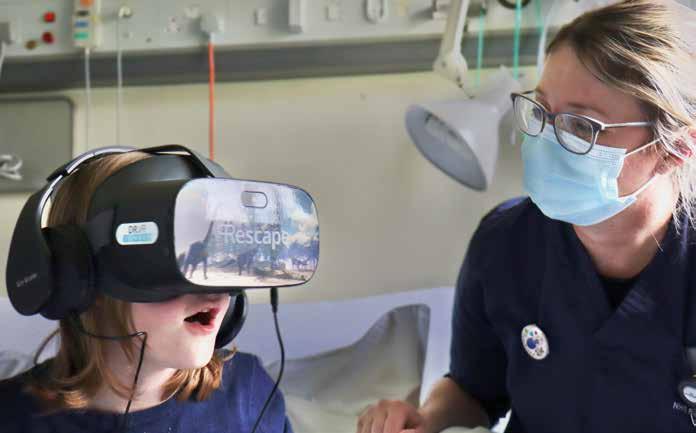
Immersive VR headsets take children on journeys under the sea, into space and even back to the age of dinosaurs – helping to create a more fun and calm environment for both the patient and their families.
Olivia Manley (pictured) was one of the first patients to use the new VR headset at the Horton General. Her mum, Sarah, described how the headset completely changed Olivia’s attitude towards her hospital visits.
‘As a parent, you never want to see your child frightened, distressed or thinking of hospital as a scary place to be. Sadly, for Olivia, she often found procedures, such as her cannula being replaced as part of her monthly infusions, the most traumatic part of coming into hospital. For us as parents, this was heartbreaking.
‘The first time Olivia used the VR headset it was like watching a different child undergo treatment. She was so immersed in what she was seeing and hearing that she didn’t even realise that the needle had gone in!
‘Now, when we go to hospital, she doesn’t even think about the cannula. She becomes immersed in the virtual world which makes us both feel a lot more relaxed about going into hospital. This VR headset has been a game-changer to us, and I’m sure countless other families.’
62 63 Find out more: www.hospital charity.co.uk OXFORD HOSPITALS CHARITY IMPACT REPORT 2023
The £7,000 Horton headset was funded by the Beadle family and their local community in Chipping Norton, as a thank you for the life-saving care their son Lucca received as a baby.
Helping relatives understand their loved ones' treatment
When the person you care about most is receiving major heart or lung surgery, or having emergency treatment, taking in all the information that is shared can be really difficult.
So, the Cardiac and Thoracic Critical Care Team asked Oxford Hospitals Charity to fund a large infographic for the Relatives’ Room to illustrate, in simple terms, the equipment used in the critical care environment.
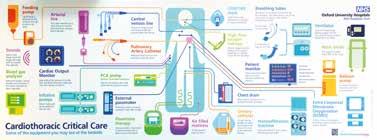
The wall-mounted piece uses illustrations and clear information to help reduce anxiety levels in patients and carers, and is a useful tool for nursing and medical staff to explain functions and procedures commonly undertaken in ICU.
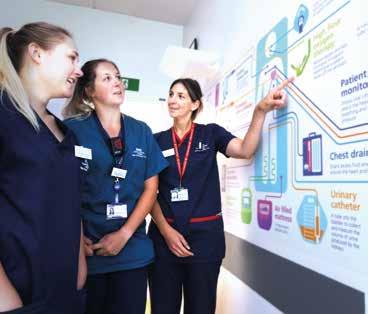
Staff in the 14-bed unit are thrilled with the piece and say it is already having great results, sparking many conversations and questions.
Handbook to help children with diabetes
For many years Oxfordshire Children’s Diabetes Service wanted to produce a publication to help children affected by diabetes.

With the support of a family fundraising for the charity, they are now proud of the bespoke publication they have created. Lead Nurse Jane Haest explains: ‘When a child is first diagnosed it can be a confusing time for them and their families – there is a plethora of information provided, so it can be overwhelming.

‘We had lots of leaflets and handouts for families to take home with them, but we really wanted to provide everything they needed in one user-friendly publication, so they could look at it at their own pace and refer back to it when needed.
‘We worked closely with children affected by diabetes and their parents to ensure we got the wording, graphics and layout just right for the patients. We are so happy with the result.’
The Service is thrilled with the positive feedback from patients and families – and now hopes to produce further handbooks for patients on subjects such as moving from children’s to adult services in the hospital and advancing diabetes technologies.
64 65 Find out more: www.hospital charity.co.uk OXFORD HOSPITALS CHARITY IMPACT REPORT 2023
Bringing cheer to Robin’s Ward
Robin’s Ward in the Oxford Children’s Hospital is the paediatric specialist surgery ward. Most of the children looked after on the ward are under the care of the Neurology, Neurosurgery and Ear, Nose and Throat teams, with many having craniofacial surgery and operations for cleft palate conditions.
Like several other clinical areas across the Trust, Robin’s had to be flexible and adapt by merging departments throughout the pandemic, sharing their space with other teams.
As a result of this constant change, the ward was in need of a spruce-up and the introduction of new artwork to transform the space. With bright colours, characters and shapes on the walls, windows, ceiling tiles and bed bays, and of course, a happy looking red-breasted friend at the entrance, Robin’s Ward is now once again a cheery and child-friendly environment.
As well as welcoming families on to the ward, the commissioned artwork by Stephen Smith provides imagery for staff to use to engage children; particularly in areas like the treatment room, where procedures take place.
It also creates a more positive working environment for staff, and establishes a supportive environment for parents and carers.
In addition, new indoor play equipment has been provided for the ward, including a virtual reality headset, sensory ‘pick up and play’ items, a play kitchen, gym mats, baby mirror mat, visual and audio sensory toys, height adjustable gaming cart with adaptable controllers, cot mobiles and musical instruments.
Plans are currently being drawn up for a full refurbishment of the outside play area to ensure the space is both functional and stimulating for Robin’s Ward patients to enjoy. Outdoor play equipment will also be purchased to complement the new facilities, including a playhouse, musical play panels, slides and various ride-on toys.
Children’s Hospital Matron, Zoe Pooley, is delighted with the new improved Robin’s Ward, exclaiming:


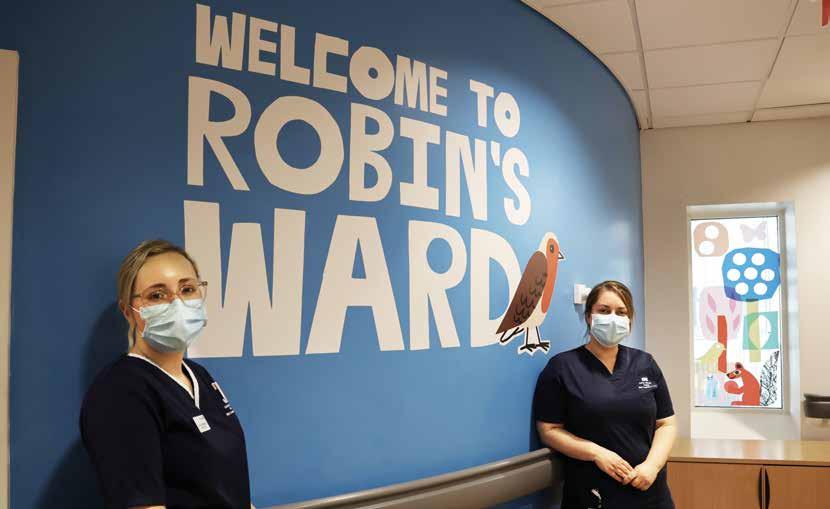
‘It is just lovely and has really transformed the space, making it so much more positive for our patients, their families and of course the staff on the ward. We love it.’


The refurbishment is just lovely and has really transformed the space. We love it!
Zoe Pooley, Children’s Hospital Matron
66 67
‘ ‘ Find out more: www.hospital charity.co.uk OXFORD HOSPITALS CHARITY IMPACT REPORT 2023
Creating information films to inform and reassure
Thanks to the generous funding and enthusiasm of the Ashley Charitable Trust a suite of patient information films have been created with many more in the pipeline. The emotional impact of hearing about a new medical diagnosis cannot be underestimated.
There can be a daunting level of information to try and absorb and patients often find themselves wishing they had taken notes or asked more questions.
So in recent years a series of professional and comprehensive videos to help patients better understand their condition and the different treatment paths has been created.

Videos for the Oxford Cancer and Haematology Centre, based at the Churchill Hospital, were created thanks to funding from the Ashley Charitable Trust.
Filmed at the Churchill Hospital and in the homes of local patients, they cover topics including finding a lump in the breast, having chemotherapy and what to expect when having radiotherapy.

Links to the films are shared with patients during consultations, and can also be found on the Trust’s website or YouTube, where they have now had over 750,000 views in total (at the end of 2022) reaching a worldwide audience.
Neil Ashley of the Ashley Charitable Trust told us: ‘I am so pleased with the impact of these films, which improve the consultation process and give patients more comfort and confidence during these important stages of treatment. It is also pleasing to see how far and wide they have been viewed.’
Tamsin Rawlings from Oxford Hospitals Charity adds:
‘The impact of the films continues to grow, and the clinical teams have described them as an ‘invaluable resource for patients’ as they provide vital information about their upcoming treatment and a chance to see the team and the environment prior to admission.
‘We’ve been told that consultations are not only quicker but also more productive, as patients have watched the films and come prepared with questions.
‘They are also able to watch them back and share the videos with friends and family, helping to ease anxiety in their support network.’
Oxford Hospitals Charity has also funded videos for teenagers and young adults having radiotherapy, and one for children coming to the Children’s Hospital for surgery, which has had over 600,000 views.
The Heart Centre has also benefitted – with patients now given access to a range of information videos to give patients and their families a good understanding of procedures before they take place – including angioplasty, pacemaker insertion, internal cardio defibrillator insertion and atrial septal defect closure.
They are made using simple animations and come in multiple languages.
The cardiac videos have received extremely positive feedback from patients and clinicians, and are currently getting about 1,500 views a month.
More films are in the pipeline, with an introduction to haematology, bone marrow transplant, colorectal surgery and breast cancer surgery videos all being created.
68 Find out more: www.hospital charity.co.uk OXFORD HOSPITALS CHARITY IMPACT REPORT 2023
bespoke patient videos
Entertaining children in hospital with toys, tech and games
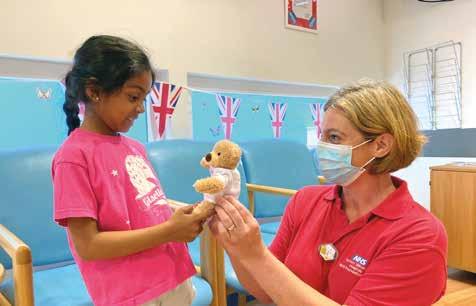
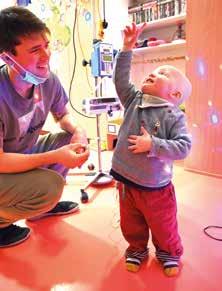
The Play Specialists in our hospitals have such an important role – coaxing giggles from babies in pain, distracting toddlers during difficult procedures, and calming teens anxious about what lies ahead.


They are simply invaluable, and the Oxford Hospitals Charity team is proud to support them through our funding for toys, tech and play areas.


We learned that some children only had access to laptops to keep up with studies during the opening hours of the hospital school – meaning they were without them in the evenings and weekends – an issue quickly rectified thanks to the support of our donors.
Extra iPads, complete with easy-to-use toughened cases and noise-cancelling earphones, are also provided to help entertain and distract children –many with additional needs, including autism. Keeping the play rooms well stocked with a good supply of toys, books, games and art and craft materials, and providing PlayStations, consoles and a good stock of video games also happens throughout the year.
The charity has even collaborated with the Phoenix to create a bespoke comic that explains what happens when having surgery in our hospitals, as well as being fun to read and packed with activities.
And every Christmas we work with the Play Specialists to provide funding that ensures every child in hospital has a special gift, thanks to our annual fundraising appeal.
70 71 Find out more: www.hospital charity.co.uk
Supporting our hospital Staff

Few would that argue that the experience of working in hospitals has changed hugely in recent years – with NHS staff often feeling overwhelmed and exhausted by relentless pressure.
During the pandemic we became acutely tuned in to the needs of our NHS staff and worked extremely closely with them on our Trust’s wellbeing and mental health initiatives.
This has continued – with the charity providing further funding to give much needed practical support for mental health, wellbeing and creating better spaces for staff to take a break.
Looking after the NHS staff who look after us is key for our charity – and we know it is important to our supporters too.
Caring for those who care for us
Many of the donations we receive mention the kindness and compassion of hospital staff, and request that something ‘nice’ is done for them by way of thanks.
So, providing staff with a boost, making sure special moments are marked and celebrating excellence within our hospitals – which all help raise morale and improve wellbeing – have continued to be a strong focus.
And initiatives that provide support at a higher level, such as helping to provide quality staff accommodation, are also in progress, with plans to do even more in this area.
73 OXFORD HOSPITALS CHARITY IMPACT REPORT 2023
Helping hospital staff to Rest, Reflect and Recover
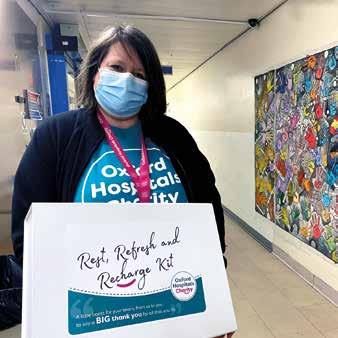
Oxford Hospitals Charity was successful in bidding for £150,000 from NHS Charities Together (NHSCT) in 2021, to help address some of the psychological needs of hospital staff as we began to come out of the COVID-19 pandemic.
The grant enabled us to fund Clinical Psychology and Psychiatry staff for a dedicated Psychological Medicine Staff Support Service.
The programme offered bespoke individual and team-based compassionate therapies and wellbeing information to protect mental health and build resilience.
Dr Simon Prangnell, Consultant Clinical Neuropsychologist and Clinical Director for Psychological Medicine,
said:
‘We are incredibly grateful for the funding which allowed us to provide rapid access to specialist assessment and treatment for staff who have been affected by the pandemic and the challenges associated with working in an acute hospital.’
Funding equipment for staff recovery and wellbeing
Working closely with the Trust’s wellbeing leads, in 2022 the charity identified the staff areas in our Trust most in need of extra support.
Since it stared the service has:
■ provided individual therapy for 150 staff to help with issues including anxiety, depression, work-related stress and PTSD
■ organised reflective away days for 500 staff, with 95% saying that they found the programme helpful and 92% saying that they would recommend it to others
■ supported 80 teams with issues including exposure to distressing incidents, PTSD and managing stress.
Head of Programme Hazel Murray explains: ‘We know that providing equipment specifically to aid relaxation during breaks which encourages staff to prioritise their mental and physical health – helping staff wellbeing and retention.
‘This built on earlier support in 2020 where we funded rest pods for the Emergency Departments at the JR and Horton, to give frontline staff an extra boost during their breaks or at the end of intense and stressful shifts.’
Even the smallest staff room can accommodate a massage seat-pad, giving teams a moment to focus on themselves, even for a few minutes, and return to their patients feeling a little more refreshed and re-energised.
‘In partnership with the Trust’s Culture and Leadership Service, requests were collated and prioritised before equipment was distributed across the hospitals – as we know that by looking after our staff we are in turn supporting our patients.
These projects were also funded with grateful thanks to NHS Charities Together
74 75
FUNDING enabled this significant support to carry on until the end of 2022, and has been so important that our NHS Trust is now investing to continue this work.
Find out more: www.hospital charity.co.uk OXFORD HOSPITALS CHARITY IMPACT REPORT 2023
New accommodation for key NHS staff
Like many NHS Trusts, finding and retaining hospital staff is an ongoing concern – but in Oxford the problem is compounded because the disparity between housing costs and wages is one of the worst in the UK.
This enduring problem prompted the Trust and charity to come together to work on an ambitious programme to create more affordable and better quality staff accommodation on our hospital sites.

In 2022 this culminated in the opening of Spencer Court, brand-new accommodation for new hospital staff, based at the Churchill Hospital.
Built and managed by a housing association which leases land owned by the charity, Spencer Court can now provide a home for 91 hospital key workers, at below market rate.

Arranged as 19 fully furnished flats, each with three or five en-suite bedrooms and a central living and dining area, the first NHS workers moved in at the end of 2022.
At the official opening, Professor Sir Jonathan Montgomery, Chair of Oxford University Hospitals, said: ‘For new staff coming to Oxford for the first time, finding good quality, low rental housing within walking distance of the Oxford hospitals is daunting.
‘ That is why our onsite accommodation is so important. It gives our new staff the time and safe space to get to know the area and find flatmates to share with in the future.’
Professor David Matthews, Chair of Oxford Hospitals Charity, added: ‘This is an extremely important project for all involved, and it is wonderful to hear the positive reaction from those moving in. Everyone living in Oxfordshire knows that the lack of affordable housing is a cause of major concern, so our charity is delighted with this collaboration to support the accommodation needs of vital NHS staff.’
76 77 Find out more: www.hospital charity.co.uk OXFORD HOSPITALS CHARITY IMPACT REPORT 2023
PICTURED: Spencer Court was officially opened for staff in November 2022
Raising smiles across our hospitals
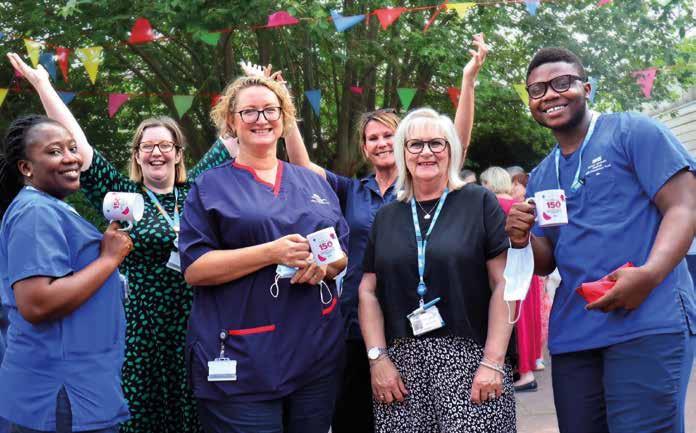
During some of the toughest years in our NHS history the charity has worked diligently to ensure that important dates and milestones – from International Nurses’ and Midwives’ Days, through to the 150th anniversary of the Horton General, 80th anniversary of the Churchill and 50th anniversary of the JR's Women's Centre – are recognised and celebrated.
Working in collaboration with the amazing hospital volunteers, we have been out in our hospitals distributing little treats such as cupcakes and fruit baskets, marking events and raising smiles on special days.

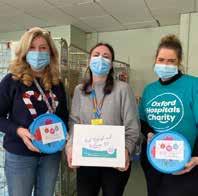

We know from staff what a difference these little boosts can make, so in the winter of 2022, with pressures in the hospitals severe once again, we introduced new Rest, Reflect and Recharge kits, distributing them to over 150 hospital teams.
These special boxes are packed with thoughtful little items to give the whole team a boost, alongside clever touches, such as handmade cards from local schools. They continue to be a real hit in our hospitals – with delivery carefully timed to reach the teams under most pressure just when they need it most.

In 2022 we were also able to reintroduce in-person events for hospital staff, which meant the return of the Annual Staff Recognition Awards

Oxford Hospitals Charity has long recognised the importance of events like these to celebrate excellence and thank hard working teams, so was delighted to support this very special event.
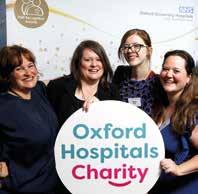
78 79 Find out more: www.hospital charity.co.uk OXFORD HOSPITALS CHARITY IMPACT REPORT 2023
Creating calm and understanding through poetry, music and art
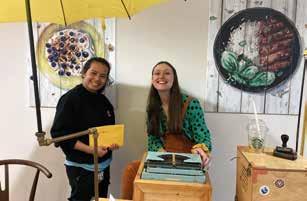
A key lesson from the pandemic was how the arts can help bring NHS teams closer, to decompress and deal with trauma, stress and exhaustion. Initiatives supported by the charity, such as the One Voice staff choir, are proving increasingly popular. Up to 50 staff in Oxford come together every week to sing, with a Horton-based choir also starting up in late 2022.
Stitched artwork by Harriet Riddell has been created by involving staff from across the whole Trust who came together to support the historic work of the vaccination programme.
Using poetry to voice and share emotions has also shown real value. Beth Calverley is our Trust poet, and she has worked with over 15 hospital teams, from the Dementia Leads and Play Specialists to Chaplains and Tissue Viability.
And the creativity of staff in our hospitals has also been celebrated, with staff artwork from the pandemic framed and initiatives such as an ‘NHS Unmasked’ photobook featuring cancer centre staff in and out of uniform.

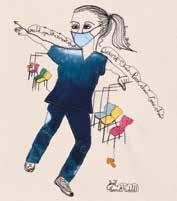

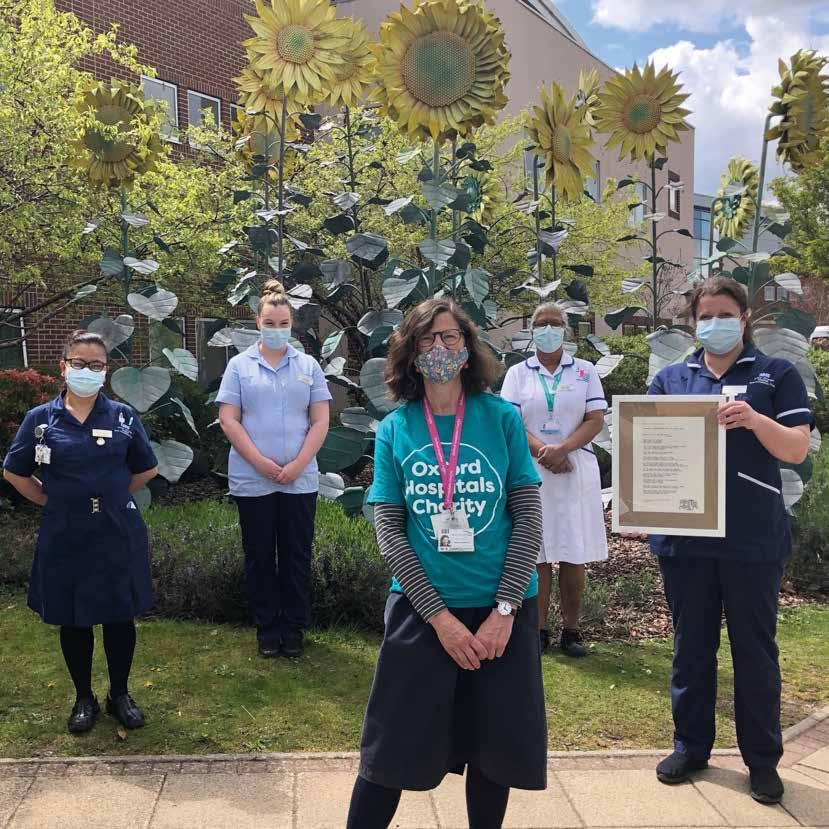
80 OXFORD HOSPITALS CHARITY IMPACT REPORT 2023
Supporting specialist training and research
As a teaching Trust that is partnered with the University of Oxford, we are proud of the important medical research and teaching that takes place in our hospitals.
Oxford Hospitals Charity has continued to act as a significant source of funding in this area contributing towards many research and specialist training projects.
In some cases the charity offers seed funding to get research off the ground, while other projects have longer-term commitment thanks to the generosity of donors who have a particular connection with the area of research.
Every year we fund dedicated research into childhood and adult cancers and cardiac conditions, Alzheimer’s disease, craniofacial conditions, brain injury, foetal conditions and many other important medical areas.
We are also delighted to have commenced funding to enable more nursing and midwifery staff enter the realm of research, exploring practical hospital-based ideas which have a direct impact for our patients.
Enabling e-learning for teams across our hospitals
The impact of the pandemic has led to a significant shift in how some staff education and training is delivered in our hospitals – and getting the correct approach and infrastructure in place from the start has been key.
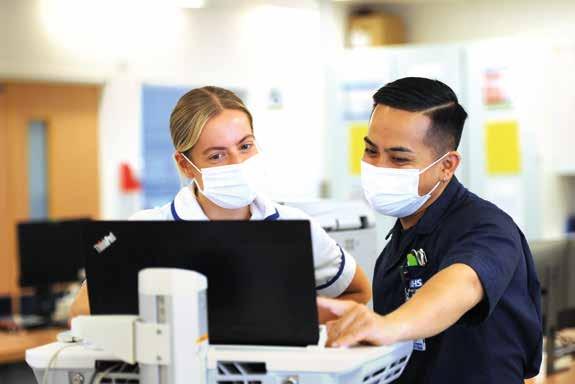
Understanding this, the charity could see real benefits in the creation of a Learning Technology Lead to help develop, implement and support the delivery of a suite of interactive e-learning materials, projects and activities – all linked to the Trust’s bespoke clinical education programmes.
Funding from the charity for this new post was agreed in the summer of 2021, to cover the initial 24 months for this new role, working across all the clinical Divisions.
Over £100,000 of funding
83
Launching hospital-based research projects
An innovative programme to support research and practice improvement by nurses, midwives and allied health professionals was launched in Autumn 2022.
Funded by Oxford Hospitals Charity, the new initiative aims to encourage staff to find practical and impactful solutions to a number of hospital challenges, such as preventing falls and hospitalacquired pressure ulcers and improving intravenous nutrition for patients.
The Oxford Hospitals Charity Chief Nursing Officer Fellowship scheme invited staff from across the Trust to apply for the six-month programme.

Five staff, including three nurses, a midwife and a pharmacist, were chosen for the first round of the fellowship – which provides them with the tools, time and support through a structured research programme to focus on areas that the Trust is keen to improve.
Each member of staff taking part in the fellowship scheme is provided with a mentor and regular access to a senior clinical expert and quality improvement lead within the hospital Trust to help them. They are also given two days a week for six months to focus on the research work.
At the launch event, Chief Nursing Officer Sam Foster said: ‘It is so exciting to see our first cohort and hear their eagerness to get going.
‘Giving staff of all levels access to research opportunities is really important as it encourages new ways of thinking, innovative ideas and solutions to improve patient care, as well as helping them grow their experience.’
Initial evaluation of this scheme is very positive, and the charity will explore making this a rolling programme going forward.
We are incredibly grateful to Oxford Hospitals Charity for supporting this initiative.
Sam Foster, Chief Nursing Officer
‘ ‘ 84 85 Find out more: www.hospital charity.co.uk OXFORD HOSPITALS CHARITY IMPACT REPORT 2023
We support many of the smaller research projects through the Oxfordshire Health Services Research Committee.
This subcommittee of the charity has input from the University of Oxford, Oxford Brookes University and Oxford University Hospitals NHS Foundation Trust. The funds they distribute come from the broader research funds of our charity as well as an annual donation from Nuffield Oxford Hospitals Fund Charity.
Lymphoma cancer research taking place at the Churchill Hospital
Lymphoma cancers are the fifth most common type of cancer in the UK. The Julian StarmerSmith Lymphoma Fund supports important research into these blood cancers – providing funding for sample storage and analysis to help with a number of larger research projects that aim to identify how patients will respond to different treatments.
Dr Graham Collins explains: ‘A critical piece of research is looking into whether we can predict which patients are going to respond well to an immunotherapy drug in patients with relapsed Hodgkin Lymphoma.
‘If we can use the right drug for the right person, we can enable them to proceed to potentially curative therapy with a stem cell transplant more safely and effectively.
‘We remain incredibly grateful to those who donate and fundraise so generously to support this important work.’
International study into muscular disease
The John Radcliffe Hospital is internationally recognised as a leading organisation in the investigation, diagnosis and treatment of patients with Inclusion Body Myositis (IBM).
IBM is an inflammatory neuromuscular disease, commonly found in older adults, for which there is currently no effective treatment.
Funding from Oxford Hospitals Charity has enabled the Neurosciences team to join an international investigator-led study to look at recent positive data in the treatment of IBM.
The trial will take place over an 88-week period as a Phase III, randomised, double-blind and placebocontrolled, international study in which the John Radcliffe is the only UK centre included.
Data for autoimmune liver disease research
Oxford has established itself as the clinical tertiary referral centre and translational research hub for patients with autoimmune liver diseases.
There are currently 10 clinical trials and six translational research studies taking place in Oxford, working towards creating new therapies in these rare diseases that currently have no medical cure.
These studies involve over 15 Trust staff and University members including multiple specialty consultants, clinical and research fellows, clinical research nurses, masters’ students and medical students.
Central to this work is data collection for treatment, targeted research studies and clinical trials.
Funding from Oxford Hospitals Charity is helping the upkeep of the rare disease autoimmune liver databases for Hepatology. These data go towards integral research that has been taking place since 2007.
The benefit from this project is far-reaching at a national and international level.
86 87 Find out more: www.hospital charity.co.uk OXFORD HOSPITALS CHARITY IMPACT REPORT 2023
New bone marrow cancer treatments and research
Thanks to the generosity of our charity donors, clinical teams based within the Department of Haematology at the Churchill Hospital are now able to help current and future patients benefit from exciting new therapeutic developments in cancer care. Previously the only treatment options for bone marrow cancers depended on the use of toxic chemotherapy, sometimes alongside bone marrow transplantation. Whilst these treatments benefitted some patients, the side effects of treatment could be massive and in many cases patients may not be fit enough to be treated.
The treatment of two bone marrow cancers –Myelodysplastic Syndromes (MDS) and Acute Myeloid Leukaemia (AML) is now undergoing an unprecedented period of improvement. This includes the development of new drug therapies which are targeted specifically at the underlying disease and do not have the common side-effects of chemotherapy such as gastrointestinal damage, infection risks and hair loss. Some of these new drugs help the body’s own immune system destroy the cancer cells.
Looking ahead, and thanks to a very generous legacy, the clinical teams at the Churchill will now be joined by dedicated research doctors and nurses, who can oversee the safe introduction of these new treatments to the benefit of our patients with AML and MDS.
Dr Andy Peniket, Haematology Consultant and Lead for Innovation for Oncology and Haematology, said: ‘We cannot express enough how grateful we are to the Oxford Hospitals Charity and their kind donors for the support that they are giving our team. We are incredibly excited at the new treatment options that we can now access for our patients. These treatments will be both better and safer.’
Exploring the relationship between Sleep Apnoea and Type 2 diabetes
Obstructive Sleep Apnoea (OSA) is associated with Type 2 diabetes mellitus (T2DM) but there is little evidence from robust studies to show an effect of OSA in raising glucose levels.
This research uses continuous glucose monitoring to record glucose levels every five minutes throughout the day and night in patients with and without treatment of their OSA.
Funding towards two research posts has allowed this research to commence from October 2022 and this project aims to definitively determine the effect of OSA on glucose levels.
Looking ahead
It’s an exciting time for Oxford Hospitals Charity as we are fortunate to work with many world-leading clinicians and ground-breaking services in our hospitals.
Thanks to the exceptional generosity of our supporters, the funding we provide allows us to initiate innovations and enhancements to transform the hospitals that care for you and your loved ones.
In 2023 we are looking forward to opening the new Heart Centre cath lab, funded through our Heartfelt Appeal, and opening a new Education Centre, funded by a legacy, to support staff training and education within our Trust.
We’re also excited to be exploring a potentially transformative project to help the most critically ill children in our hospitals.
With the need greater than ever, we are eager to do more, so the charity is also working hard to raise its visibility within our hospitals and the wider community so that more people are aware of the work we do and inspired to support our very special causes.
…
88 OXFORD HOSPITALS CHARITY IMPACT REPORT 2023
State-of-the-art cath lab for heart patients
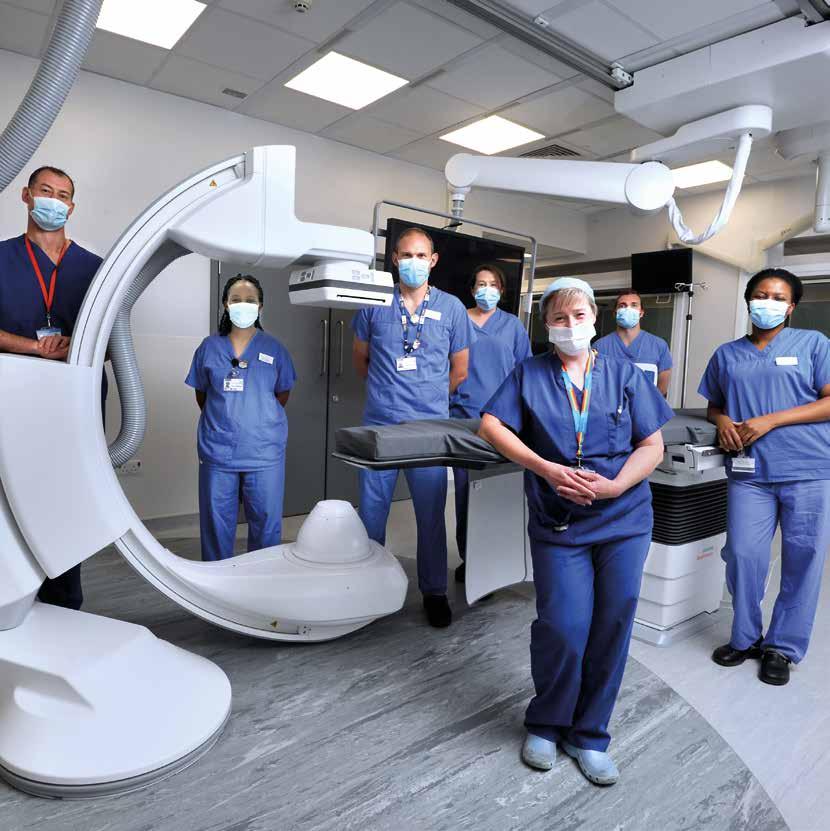
In 2022 we launched an £800,000 appeal to help fund a new state-of-the-art catheterisation laboratory (‘cath lab’) for the Oxford Heart Centre.
This centre of excellence for cardiothoracic care looks after over 20,000 patients from the Thames Valley area and beyond every year, many needing complex and life-saving care.
The cath labs are used for minimally-invasive heart procedures such as angioplasties to widen the arteries, ablations for the correction of abnormal heart rhythms and repairing structural problems with valves and holes in the heart, as well as procedures for patients who are too weak for major heart surgery.
But technology moves fast, and new innovations mean there is now more we can do to help save and improve local lives.
Sam Dawkins, Consultant Interventional Cardiologist, told us ‘The centre has one of the largest specialist structural heart programmes in the United Kingdom and we are one of only a handful of centres performing some of the most complex procedures in the UK.
‘Our NHS Trust has upgraded the specialist cath labs at the John Radcliffe Hospital, and with the charity’s help, we will be able to ensure they are equipped with the very best technology available – with much higher quality imaging which is particularly beneficial for complex structural interventions.
‘This will help patients suffering from structural heart conditions receive the very best possible care.’
To support the Oxfordshire Heartfelt Appeal visit: www.hospitalcharity.co.uk/heartfelt
We have a world-class team at the Oxford Heart Centre, and we need a world-class cath lab to further enhance their skills and support our patients.
Dr Sam Dawkins
90 91
‘ ‘ OXFORD HOSPITALS CHARITY IMPACT REPORT 2023
Oxford Hospitals Education Centre
Oxford University Hospitals NHS Foundation Trust is based in a city with a worldwide reputation for education, however within our hospitals space for teaching and learning is scarce.
The charity has approved funding to support the creation of a brand-new dedicated education centre to provide a permanent home for education and training across a wide range of clinical areas.
The facility, housed at the top of the new Critical Care Unit at the John Radcliffe, will allow training and education of around 1,600 hospital staff in its first year, with the number benefitting expected to increase significantly year on year.
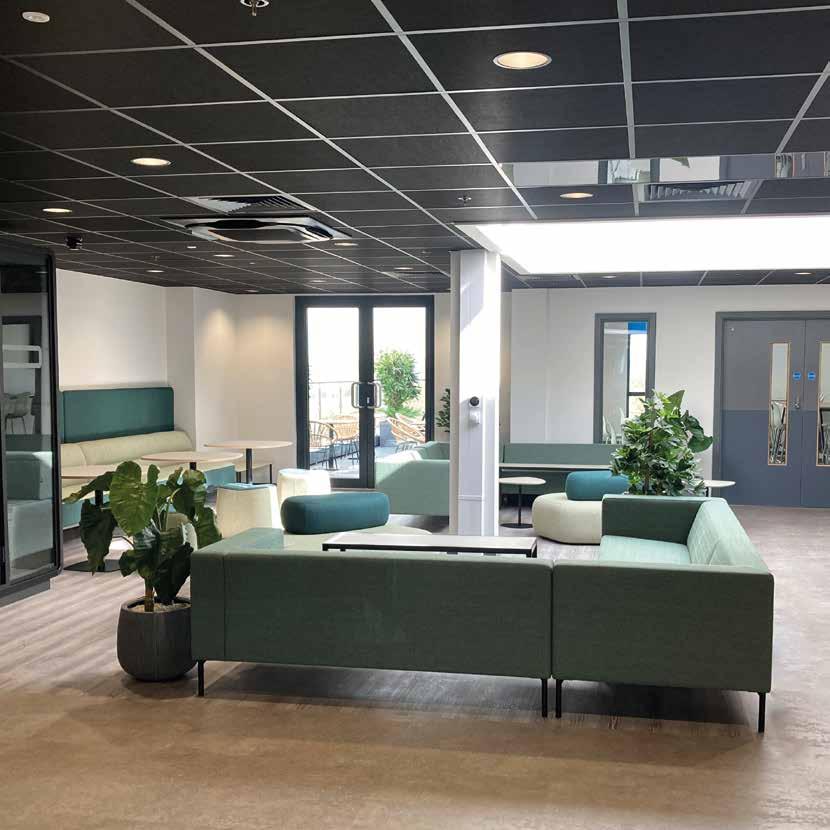
Critical Care and other hospital staff will also have access to some parts of the centre during breaks and at the end of long shifts, as well as utilise the quiet spaces for work and study. With the help of a significant legacy we have been able to fully support this important project by providing £1.2 million of funding.
CEO of Oxford Hospitals Charity, Douglas Graham, said: ‘The new centre will create a first-class base for many education and training sessions, and, by reducing the need to hire off-site venues, will reduce ongoing costs for our NHS Trust.
‘Continuous learning for both new and long-term staff is so important – helping to raise standards of patient care and enable exciting medical innovation, as well as being a cornerstone of staff recruitment and retention. In short, teaching is at the heart of the NHS and we are delighted to be able to play such a significant part within our Trust in this field.’
The new facility will open to staff in Spring 2023.
‘ ‘
92
OXFORD HOSPITALS CHARITY IMPACT REPORT 2023
£1.2 million of funding
A message from our CEO

Our charity team is passionate about the hospitals we serve. Like you, they look after our families, friends and loved ones .
We know just how precious your donations are and how important it is that we use them wisely to have the biggest impact across our hospitals possible over the short, medium and longer term.
To provide clarity to our supporters, we split our costs into these three main areas – the amount we spend on funding projects across the four hospitals (which is always by far the majority of our spend), the costs of raising funds, and the normal costs of running an organisation.
Throughout this report you will have read much about the impact of the projects funded thanks to your generosity. We are delighted to show you just some examples of the transformative effect of your gifts. The projects we support are driven by needs identified by staff we work with in the hospitals, and always with the ultimate goal of benefitting patients.
72% of our expenditure in our most recent financial year went directly on funding our charitable work taking place across Oxford University Hospitals NHS Foundation Trust.

The costs of raising funds over this period amount to 12% of our total spend. Having a fundraising team and actively raising the profile of the charity is really important for all charities – think of it as an investment for the future.
Importantly we know that for every £1 we spend on this area we generate over £4 in return, which then fuels our next set of projects.
Our running costs include office rental, our finance department (which manages all the income and expenditure) and governance to ensure all our work is done in line with charity law and Charity Commission guidelines.
As well as thinking of what is needed now, we also need to plan for the future. Our fundraising and finance systems had become outdated, so the running costs of 16% include the one-off costs of replacing these systems. We have also invested to develop and launch some new fundraising activities which will raise even more money over the coming years. All this is done so that we can fund more support each year across the four hospitals.
With the dedication of the charity team, and the oversight of our Board of Trustees, you can be confident that we are an efficiently run charity, focused on delivering the best possible support to patients and staff at a time when it has never been more needed.
The past years have not been easy for the hospitals of the OUH and I am incredibly proud of what the charity has been able to achieve during and following the pandemic.
Looking ahead we are excited at the possibilities to provide more, to make each of our wonderful hospitals an even better experience for patients in our community. And we know that this can only be done thanks to your support and that of thousands like you.
We hope this report has inspired you to continue to help us with this vital goal.
With my very grateful thanks.
How we manage our funding
In the most recent financial year (2022/23) 72p of every pound was spent directly on our core charitable aims. 16p was spent on making sure we are a well run charity (covering governance, finance, IT and office costs) and 12p was spent on fundraising and marketing.
Dr Douglas Graham CEO, Oxford Hospitals Charity
94 95
OXFORD HOSPITALS CHARITY IMPACT REPORT 2023 Find out more: www.hospital charity.co.uk
12% 16% 72% Charitable expenditure Essential running costs Generating income
Keeping in touch
If you would like to know more about how you can help our charity to continue its important work across the John Radcliffe, Churchill, Horton General, Oxford Children’s Hospital and Nuffield Orthopaedic Centre, please visit our website or get in touch.
e: charity@ouh.nhs.uk t: 01865 743 444 www .hospitalcharity.co.uk

Oxford Hospitals Charity OxHospCharity Oxford Hospitals Charity
Postal address:
Oxford Hospitals Charity
Wood Centre for Innovation
Quarry Road, Headington
Oxford, OX3 8SB
To make a donation to support our work, you can use our website or send a cheque made payable to Oxford Hospitals Charity to the address above. Donations will support 'wherever the need is greatest' but if you would like to specify a particular hospital or area, just let us know.
Registered charity no. 1175809

Our very special thanks to you
None of the innovations and improvements detailed within these pages would be possible without the generosity of our community of supporters. We’d like to share our heartfelt gratitude to every individual, business, group and grant funder who has donated, taken on a challenge or promised future support through a gift in their Will.
This booklet is dedicated to you all, with our sincere thanks for your kindness.
Find out more: www.hospital charity.co.uk
Photography throughout is copyright Oxford Hospitals Charity and Jon Lewis / Oxford Hospitals Charity
This publication has been designed by our good friends at Oxford Medical Illustration (OMI).
96



Oxford Hospitals Charity e: charity@ouh.nhs.uk t: 01865 743444 Making a difference across your hospitals www.hospitalcharity.co.uk POSTAL ADDRESS: Oxford Hospitals Charity Wood Centre for Innovation, Quarry Road, Headington, Oxford, OX3 8SB Registered charity no. 1175809 With special thanks to Fine Print in Witney for supporting this publication. Oxford Hospitals Charity OxHospCharity Oxford Hospitals Charity






































































































